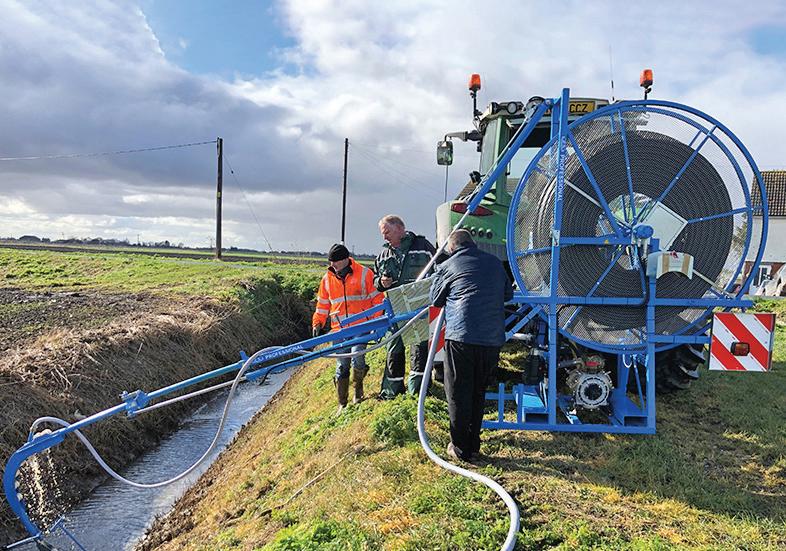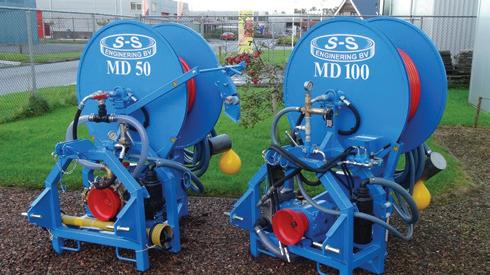













































EDITORIAL
Editor:
Johann Tasker | T: 07967 634971
E: johann@ruralcity.co.uk
Design:
Mark Shreeve | T: 01502 725839
E: mark.shreeve@micropress.co.uk
Advertisement production:
Polly Coleman | T: 01502 725841
E: polly.coleman@micropress.co.uk
Gemma Mathers | T: 01502 725813
E: gemma.mathers@micropress.co.uk
Callum Hoffman | T: 01502 725840
E: callum.hoffman@micropress.co.uk
ADVERTISING SALES
Danny Lewis | T: 01502 725862
E: danny.lewis@micropress.co.uk
Harvey Taylor | T: 01502 725804
E: harvey.taylor@micropress.co.uk
Lawrence Kenny | T: 01502 725860
E: Lawrence.kenny@micropress.co.uk
Midland Farmer is a controlled circulation magazine published monthly for farmers and growers in the Midlands (Derbyshire, Herefordshire, Leicestershire, Lincolnshire, Northamptonshire, Nottinghamshire, Shropshire, Staffordshire, Warwickshire, West Midlands and Worcestershire) or companies supplying goods and services to the sector. To be included on the circulation list, a farmer must have a minimum of 70 acres of land, or 50 dairy/beef stock, or 50 breeding sows/250 growing stock, or 15,000 laying hens/broiler chickens. Intensive horticulture units are required to have a minimum of two hectares.
If you no longer wish to receive this magazine, please email your name, address and postcode as it appears on the wrapper to gemma.mathers@micropress.co.uk
© Countrywide Publications 2024
Published by Countrywide Publications, Fountain Way, Reydon Business Park, Reydon Suffolk IP18 6DH T: 01502 725800
Printed by Micropress Printers Ltd T: 01502 725800

he government’s latest move in the battle over inheritance tax has rightly angered farmers and farming families.
Summoning industry leaders from across the UK to attend top level talks in London raised hopes of a Treasury compromise on plans to impose inheritance tax on farming assets worth more than £1 million from April 2026.
But those hopes were brutally quashed by Treasury minister James Murray who refused to engage with farm leaders from England, Scotland, Wales and Northern Ireland.
NFU president Tom Bradshaw has rightly pledged to continue fighting for farmers. But this was the clearest signal yet that the government will not be swayed from its inheritance tax plan for farming. It might be that the policy is eventually tweaked – but clearly the government wants us to believe that it is here to stay.
In battling on – and rightly so – the NFU has to strike a fine balance. It must ratchet up the pressure without the fight becoming so all-consuming that it overshadows the impact of other government policies on agriculture.
In other words, we must realise that inheritance tax is not the only issue affecting farmers –

despite being the most high profile. Think food security, competition from substandard food imports, the need for supply chain fairness, the slow roll-out of environmental schemes, labour shortages and ongoing low investment in agriculture.
It is hard to accept, but we must also prepare for the possibility that the inheritance tax proposals may not be tweaked at all. Some farming families already have plans. But many do not. As when fighting every battle, it pays to have a contingency plan for when things go wrong.
That means considering all possible eventualities, talking to trusted advisers and revising succession plans to take into account the unwelcome situation in which we find ourselves.
It is a hard truth, but succession planning will not resolve the situation for everyone. This means checking in on other family members – especially the older generation and those who are infirm or terminally ill – and reassuring them that they are loved, valued and cherished. And that we are all in this together.
Johann Tasker Editor


• Treasury refuses to listen to farmers
• Government ‘no interest’ in moving
• Leaders propose compromise tax
Industry leaders have pledged to fight on after the Treasury again refused to back down on plans to impose inheritance tax in farmers.
It came after Treasury minister James Murray summoned farming representatives to a London meeting – only to tell them that the govern ment was determined to impose 20% inheritance tax on farm assets worth more than £1m from April 2026.
Blunt refusal
NFU president Tom Bradshaw said the government’s blunt refusal to accept any compromise would have a devas tating impact on UK farming families and the nation’s food security.
Speaking after the meeting, Mr Bradshaw said: “Disappointed doesn’t cover how I feel after this meeting. To day, we have repeated our concerns about the impact on farming fami lies – they don’t care.
“On the impact on families who can’t afford vast tax bills coming their way on the death of a loved one – they don’t care. On the elderly, who feel they are now a burden on their family – the most vulnerable people in our farming community – they don’t care.”
interest
Farm leaders from across the UK at tended the London meeting. They included Country Land and Business Association president Victoria Vyvyan, Tenant Farmers Association chief executive George Dunn and NFU Scotland president Andrew Gannon.

The inheritance tax compromise proposed by farm leaders is based on a clawback mechanism which the NFU says will raise revenue without damaging family farms.
Also in attendance were farm minister Daniel Zeichner and Treasury officials. Despite presenting alternative proposals, the farming delegation was firmly told that the government had no interest in compromise.
Jeremy Moody, chief advisor to the Central Association of Agricultural Valuers, said many farms would have to sell off land and other assets to pay
“Put simply, farmers don’t get money when they inherit, they get the farm, the business asset, and often the debt,” said NFU president Tom Bradshaw. “Any money they do get, they get when they sell.”
The NFU compromise, which is based on this premise, was suggested by tax experts. It means government will still receive its planned tax income – but inheritance tax
would be paid only if an inherited farm is sold, rather than when it is inherited.
“Crucially, this would allow family farms that want to continue to produce the nation’s food to do so, while giving the Treasury what it wants,” said Mr Bradshaw.
It was wrong for the government to argue that the £500 million raised by the tax was needed to rescue the NHS, added Mr Bradshaw.
“This amount will fund the NHS for a day,” he said. “ It’s disingenuous for ministers to repeat this untruth.”
We managed to get back to draining in February, although we did have some challenging conditions as the field we were in was good old fashioned Warwickshire clay. With the rain we had as well it turned very claggy very quickly even forcing us to pull off for a couple of days. In the end though, the client told us to just crack on as it won ’t be getting any better until the drainage is in.

The new 9” (225mm) outfall was running before we had even got any laterals in.

It wasn’t always wet, we had quite a few glorious sunsets which seemed to make all the grey days easier to bear.

We had drained these fields before, looking at the old headwall we estimated it to have been late 70’s early 80’s.

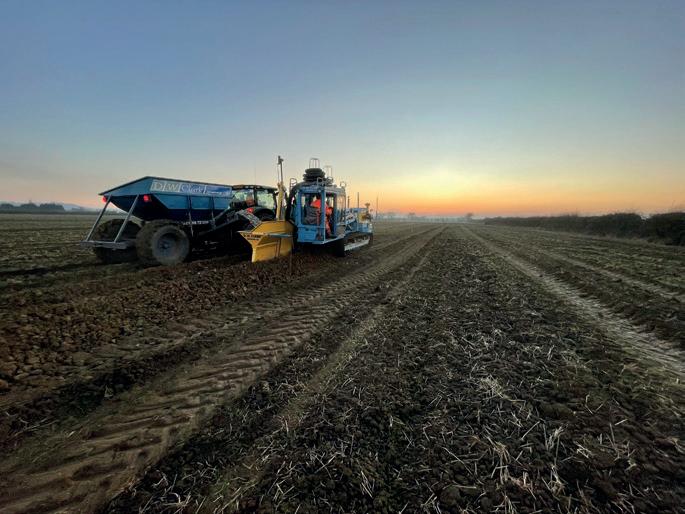

Afarming family whose roots stretch from India to Worcestershire starred on the big screen after creating a documentary mini-series.
‘It’s a Punjabi Farm Innit’ follows the journey of the Makhan Singh Padda family from the Punjab to Vicarage Nurseries, in Bretforton, in the Vale of Evesham, where they have grown strawberries and raspberries since the 1990s.
Ambition
Farmer and Worcestershire NFU member Bal Padda decided to undertake the two-part docu-series to showcase food production and the struggles of farming while also pursuing his ambition to drive diversity and inclusion in the industry.
Mr Padda started on little more than 1ha of land with little knowledge of strawberry growing. But current operations see more than 1,200 tonnes of 1st class soft fruit produced for UK supermarkets and shoppers.
The docuseries – which touches on themes of faith, resilience, and the unwavering belief in the power of hard work – echoes the experiences of farming families the world over. It premiered at the Regal Cinema in Evesham on 11 February.
Farming story
The premiere sold out in in record time, said Mr Padda. “This is about characters on the farm but it is also about food production, about farming, the struggles of farming, the dreams
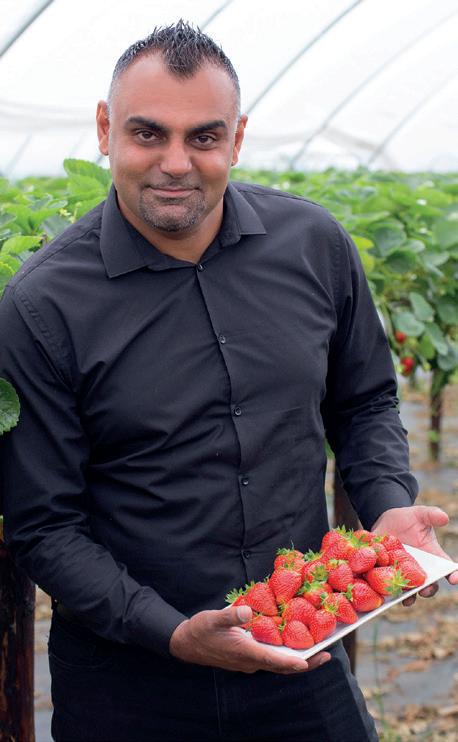
of farming.
“We used one camera, so not a massive production. The crew came in, filmed it over two days and that turned into a trailer and has now turned into a two-part mini documentary.


The Punjabi Farm film premiered last month
“This is about telling that story and relating to people. Farming embraces diversity and we want to see more of it as it is so important. We need to tell our farming story across the country using all farming voices.

To watch the trailer, visit https:// bit.ly/PunjabiFarm or scan the QR code.

Midlands MPs visited the UK’s biggest fresh milk plant last month to find out more about the British dairy sector.
They joined other MPs from across the country and from all political parties at Arla’s site in Aylesbury, in Buckinghamshire, as part of the NFU’s Food and Farming Fellowship Scheme.
Launched last year by the NUF with a number of industry partners, the scheme aims to showcase UK agriculture and enables MPs to see firsthand how sustainable and affordable food gets from field to fork.
NFU dairy board chair Paul Tompkins thanked Arla for hosting the vis-
it, saying it was important for MPs to visit farms and out more about the importance of agriculture and British dairying.
“We are sure this helped give them a wider understanding of the importance of our farms, the dairy sector and the wider supply chain and its contribution to food production, the economy, jobs, communities and the environment.”
The group toured a nearby dairy farm, run by one of Arla’s farmer owners, before heading to the processing site and touring the facility which uses cutting edge technology and innovation, including renewable energy.


After yet another wet winter, early drilled cereals are already showing significant disease pressure and will need an early and robust programme of fungicides to ensure they go on to achieve their true yield and quality potential.
Attack is the best form of defence
The critical factor in providing adequate protection from cereal diseases is to ensure that a suitable fungicide programme starts as early as possible, before infections take hold. With several fungicides showing signs of reduced efficacy due to resistance development, it is important to limit the exposure of at-risk active ingredients. This can be achieved by using a range of fungicides throughout the season, and by using different active ingredients with alternative modes of action. For example, a multi-site fungicide such as ARIZONA® should be included alongside single site actives at key stages in the crop protection programme.
ARIZONA® delivers the following benefits:
• Additional control of septoria in wheat, and ramularia, net blotch and rhynchosporium in barley. Also reduces yellow and brown rusts.
• Extends green leaf area duration and boosts yields: every £1 spent on ARIZONA® will provide a £4 return on investment.
• The only fungicide proven to extend the effective lifetime of at-risk fungicides.
‘Every £1 spent on ARIZONA® will provide a £4 return on investment’
(Based on 272 trials carried out from 2019 to 2024. Based on wheat at £200/tonne)
Multi-site efficacy and value
ARIZONA® (folpet 500 g/L) is a unique multi-site fungicide that provides valuable protection against key diseases in wheat and barley: it delivers a reliable return on investment through enhanced disease control and consistent yield improvement whilst safeguarding the efficacy of partner products.
When to use ARIZONA®
T1 is a critical timing for the control of septoria in wheat: using ARIZONA® at this timing will provide a positive yield response and reliable return on investment. A second application at T2 will further enhance disease control extend green leaf duration and maximise yield benefit as well as protect partner chemistry.
In higher risk situations (e.g. a susceptible variety facing high disease pressure), ARIZONA® should also be included at T0 to provide early season protection before diseases take hold.
In barley, ARIZONA® should be included at T2, especially where ramularia control is required. ARIZONA® can also be used at T1 when it protects against rhynchosporium and net blotch, or at T0 if earlier protection is required. To achieve the best control of both diseases and maximise yield benefit, ARIZONA® should be included at T1 and T2. For more information, subscribe to the ADAMA crop protection hub at: www.adama.com/uk/en/adama-hub
What is ‘powered by MSI Protech®’?
MSI stands for the special action as a Multi-Site Inhibitor.
Protech stands for Proven Technology. MSI Protech® is the ONLY multi-site cereal fungicide proven to prolong the effective life of single-site partner products. It’s super fine grind of active ingredients means the formulation is fully optimised for the best results.
ARIZONA® in barley
• Ramularia: T2 1.0 - 1.5L/ha
• Best guidelines for ramularia and other diseases: T1 1.0 - 1.5L/ha
fb T2 1.0 - 1.5L/ha
Max. 3.0L product/crop
ARIZONA® in wheat
• 1.0 - 1.5L prod/ha at T1 & T2 High risk => 3 x 1.0L prod/ha (T0, T1, T2) or 2 x 1.5L prod/ha (T1, T2). Consider including ARIZONA® at the first fungicide application in any crop. Max. 3.0L product/crop


















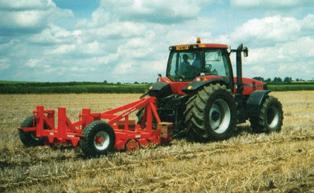

















• Industry agrees on way forward
• Goal is a more efficient system
• Next steps include funding talks
Digital passports are another step closer for cereal crops after the NFU said its concerns had been addressed.
Due to replicate the existing paper system, the digital passport will enable live assurance checks during grain collection and delivery. Weight and quality data will be passed digitally from recipient to supplier.
Some growers had voiced concern that passports wouldn’t work without a good internet connection. Others were worried about data security and commercial confidentiality. But those concerns have been overcome.
Data transfer
Where there is no internet, data will pass from one device to another via QR codes. This will ensure logistics are not held up – and the system will update automatically once the device picks up data signal again.
Growers with no computer or smartphone – and those who are unfamiliar with using such technology – will be able to telephone a helpdesk which will create and populate a digital passport on their behalf.
A joint statement from the crossindustry leadership group overseeing the digital passport process said NFU agreement was a “key milestone” – with the sector now in agreement
Grain checks will be undertaken in real time during collection and delivery

and fully aligned on the concept of a digital passport system.
Digital passports aim to achieve greater efficiency, accuracy, and traceability of data throughout the supply chain – while maintaining confidence in the safety of food and feed.
The sector is now in agreement
The leadership group has been seeking a meeting with farm minister Daniel Zeichner to make the case for initial funding. Grant funding could cover build, pilot and implementation costs.
Once the transition has been made to the new system, the AHDB cereals and oilseeds sector council has formally agreed to use levy funds to cover ongoing running costs.
Due diligence is being undertaken on the budget and delivery options.Work is being undertaken to ensure support is in place to enable a smooth transition across the supply chain. Once complete, the business case will be revised and shared with the industry.
The digital passport will initially operate in England and Wales –with an option for Scottish businesses to join voluntarily later. The Ulster Farmers’ Union is keeping a watching brief on the project.
The industry group believes a meeting with Mr Zeichner could take place as soon as this month. It says this would represent another big step on the say to the new system.
An initiative has been launched to boost UK bean production by setting out some definitive best practice guidelines for growers.
The ability of beans to fix their own nitrogen and leaving it in the soil for the following crop is well known to growers, making legumes an important UK break crop.
But the uptake of growing beans has long been curtailed by the perception that they’re unreliable – despite the multiple benefits they provide, says the Processors and Growers Research Organisation.
“The perception is real and impactful,” says PGRO chief executive Roger Vickers – even though numerous studies show that spring beans are no more unreliable than other spring sown crops.”
To put this right, the PGRO is embarking on a study to establish new best practices and recommendations for growing field beans. The goal is to optimise the on-farm yield and quality of beans as an alternative UKproduced protein source.
The project brings together the PGRO, plant breeder NPZ (LSPB), nutrition specialists Yara, and Lincoln University. It is called Answers – or Alleviating Nutritional Stress for Wider Environmental Rewards in Sustainable UK protein crop production. Real field-scale trials will be conducted to help create nutrient plans that enhance nodule activity and nitrogen fixation, boost productivity, increase yield stability, enhance protein content and encourage climate resilience.
ALincolnshire farmer who grew a record-breaking crop of spring oats won gold at the 2025 Yield Enhancement Network (YEN) awards.
Mark Popplewell credited his win to precise nutrition and an unusually wet spring. The crop of Merlin yielded 11.46 t/ha –more than double the national average –at Happy Days Farming, Market Rasen.
"The numbers were so high we thought the equipment was faulty,” says Mr Popplewell. “The grain tank was filling faster than even a strong wheat crop."
It was Mr Popplewell’s first oat harvest.
He planted 300ha of Merlin oats in late March after a wet winter. Yields reached up to 14 t/ha in some areas with advanced seed treatment, growth regulators and optimised fertiliser application.
Rotation
“We’ll grow more Merlin in 2025 as it fits well in our rotation,” said Mr Popplewell, who manages 2,000ha of arable land andbed-and-breakfast pigs.






The Yield Enhancement Network (YEN) is an independent knowledge-exchange network. It enables farmers to measure and compare their crop performance on 60 different factors – including agronomy decisions and soil health.







members to share ideas, learn from each other, and work together towards better crop yields. The award was presented to Mr Popplewell last month.
Gemma Clarke, managing director of seed merchant Cope, launched Merlin to the UK market in 2021. “Resilient seed varieties are critical as farmers face increasing challenges from climate change and unpredictable weather,” she said.


Accepted by all mills, Merlin oats are valued for their early harvest, low screenings, high disease resistance and strong yield potential. It’s one of only two spring varieties on spring oat contracts.












The network –open again to growers in 2025 – encourages





For farmers looking to plant trees, we
Give Simon a call on 07825 193278 or email: enquiries@tilhill.com




“It’s an early variety (-2), offers a competitive lodging score of 8, and has a high rating of 7 for mildew. It also has low screenings which is a real bonus to the mills and a good specific weight,” said Ms Clarke. good







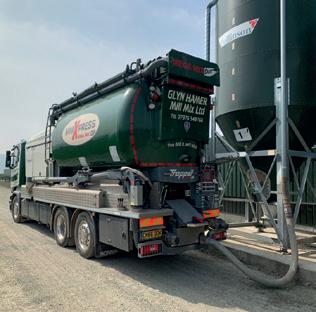



























CONVISO ® SMART represents the innovative fusion of SMART KWS Seeds with Bayer's advanced CONVISO ® Herbicide. CONVISO ® is a registered trademark of Bayer.


Revolutionise sugar beet farming with CONVISO ® SMART: advanced herbicide-tolerant KWS varieties paired with CONVISO® ONE, a targeted ALS herbicide. With effective weed control, fewer applications, and enhanced sustainability, it's trusted in 30+ countries.





Farmers preparing to tidy up stubbles ahead of spring crops are advised to check the situation in the field before filling up the sprayer.
Effective weed control from glyphosate depends on suitable application conditions – but growers reported were several cases of poor performance last spring due to prolonged bad weather.
"Last spring stretched the limits, reminding us glyphosate is not infallible," says Bayer agronomist Roger Bradbury. "Several factors combined to affect performance, and these are things to watch out for this spring too."
Spray rates should be sufficient for the most stubborn weed in the spectrum – including weeds at advanced growth stages. If there is a delay between spray recommendation and application, double-check and consider a higher rate if weeds have grown.
Avoid applications to stressed weeds which may not translocate glyphosate throughout the plant effectively. Stress most likely means waterlogging at this time of year.
Drought or prolonged cold and frosty weather are the other possible causes.
"Last spring, spray windows were few and far between meaning some farmers made applications in marginal conditions or at speeds well in excess of 12km/hour to cover the ground,” says Mr Bradbury.
Nozzle choice
"Apply with good application tech-
nique paying attention to nozzle choice, boom height and calibration. If a water conditioner is deemed necessary, make sure this is added to the spray tank first.”
Should the weather become more challenging, growers should keep in mind that modern glyphosate formulations are faster-drying and deliver more reliable and consistent levels of efficacy even under more difficult conditions, says Mr Bradbury.
In later spring, weeds at the stem extension phase of growth are often difficult to control. The glyphosate is carried upward controlling the shoot but is not translocated sufficiently to the roots so there may be regrowth.
"Allowing plants that regrow to set seed is a resistance risk.
Glyphosate is not infallible “
"The danger was underlined by the recent announcement of a resistance in Italian ryegrass – highlighting the importance of correct application and stewardship.
Stay vigilant
“Ideally, avoid regrowth situations by not applying at stem extension. But, if you notice regrowth, destroy the plants, preferably with a mechanical or chemical alternative to glyphosate."
Although the glyphosate resistance case was in Kent, Mr Bradbury recommends that all farmers with Italian ryegrass populations be particularly vigilant – wherever they are in the country.
Research in the UK and experience around the world suggests that ryegrass species are higher risk with regards to glyphosate resistance. Growers should stick to best practice for application and closely monitor performance in the field.
Anationwide initiative to assess cabbage stem flea beetle larvae levels in oilseed rape aims to encourage more farmers to grow the crop.
The project is a collaborative effort jointly funded by Hutchinsons, Agrii, and United Oilseeds. Niab scientists have been analysing oilseed rape stem samples for flea beetle larvae numbers and the results are being shared with the wider industry.
Larvae numbers
Bayer MagicTraps, used in a nationwide network set up by United Oilseeds and widely used by project partners, have already recorded rel-
atively low adult flea beetle numbers – and onfarm observations indicate fewer adult beetles this year too.
Experts say post-harvest shallow cultivation practiced by 80% of farmers could have had an impact on larvae numbers.
Regardless of this, the count is expected to offer further insights into what we might expect later this year.
Selected farmers from across the partner networks have been collecting and sending plant stems to Niab for assessment. The findings will provide valuable insight into flea beetle larvae populations and help inform future management strategies.





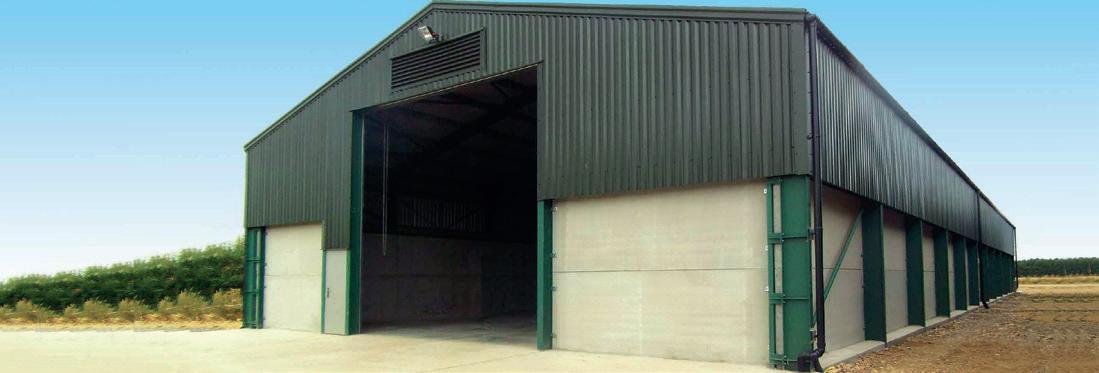















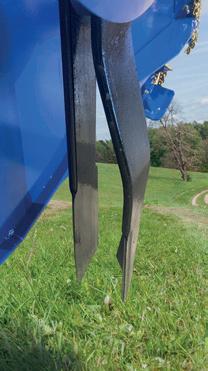

















Getting the best from nitrogen will be especially important this season, says Natalie Wood .
wet autumn and a range of drilling dates mean nitrogen applications need careful consideration
The first nitrogen application is particularly important in cereals because it affects yield potential. In wheat, for example, tillering tends to start in the autumn when the crops are at the three to four leaf stage.
During the tillering phase, the maximum number of potential florets is set. Applying sufficient nitrogen before the third week of March can help increase the number of tillers the crop puts on, meaning a higher yield potential overall.
As is often the case, unpredictable weather conditions mean that while some farmers are looking forward with their planning, some are behind schedule.
While some areas of the UK had average or below average rainfall during autumn, many areas south of the Midlands had almost 200% of the totals they’d usually expect. This resulted in a lot of variation in both drilling dates and growth stages.
The warmer temperatures seen up until the cold snap in early January may have benefits in terms of increased soil mineralisation. But it’s likely that many soils will still be deficient in nitrogen because of last year’s wet conditions.”
Farmers on track should aim for around 250 plants/m² in the spring, with first nitrogen applications adjusted according to plant


are white, it’s growing. If they are grey or pink, or they’ve been in waterlogged conditions, the advice is to be patient.
population and growth stage. Crops on target with 250 plants/m² should receive about 60kgs of nitrogen.
So, the big question is: what should farmers be looking at in terms of products?
Presuming you’re going to need sulphur too, I'd recommend something like YaraBela Axan. If you want some phosphate and potash – good for most crops when spring soil temperatures are cold – look at a product like YaraMila 52S or Actyva S.
“ Many soils will still be deficient
In the case of backward crops, they will need a bit more of a helping hand.
As there’s only a limited amount of time to increase the number of tillers and late drilled crops are already going to have fewer tillers, the focus should be on helping them with some early nitrogen – at a higher rate.
Instead of 60kg/ha of nitrogen, farmers should look to apply 80kg or even slightly more depending on the situation. As well as an adequate amount of nitrogen, the timing of that first application is crucial too.
It should be applied as soon as possible once the crop is growing. If the crop isn’t growing, it won’t take up the nitrogen and there’s potential for nutrient loss.
To check the crop is growing, dig up some plants and look at the roots. If the root tips
If your cereals are particularly backwards, consider a split first nitrogen application. You might want to apply 40kg/ha followed by 40kg, but bear in mind that if the crop responds well you will need to get back in with the second application quite quickly.
Given that last year’s flooding not only damaged soil structure and washed away crops, but also depleted soils of micronutrients, farmers are encouraged to make use of them as well as phosphate and potash to kickstart growth and maintain momentum.
Assessing the quality and status of soils doesn’t have to be guesswork. Yara has some helpful tools available, including soil analysis that can tell you everything from how many microorganisms are in the soil to whether pH is right.
Getting the pH right ensures more nutrients are available to the crop. Tissue analysis allows you to understand whether micronutrients are getting into the crop, and grain analysis enables better decisions about what you need to apply this season.
Yara’s digital Atfarm tool also helps farmers make more informed decisions about what to apply. It allows you to adjust nitrogen recommendations based on what the crops are telling you.
Grain analysis is a backward look, but you can compare what it tells you about the soil content with your most recent soil analysis to see how much you have lost in any flooding situation.
Natalie Wood is a Yara crop nutrition agronomist. For details, visit www.yara.co.uk










Forage Harvester Spares (all makes) Rake, Tedder & Mower Parts (all makes)
Maize Header Parts
Kemper, Claas RU/Orbis
Filter
for SPFH & Tractors (all makes)
• Improved nutrient use efficiency
• Creates the ideal conditions for soil microbes to thrive
• Calcium enhances soil structure and root development
Speak to our expert team about LimeX Customer service 0800 090 2376



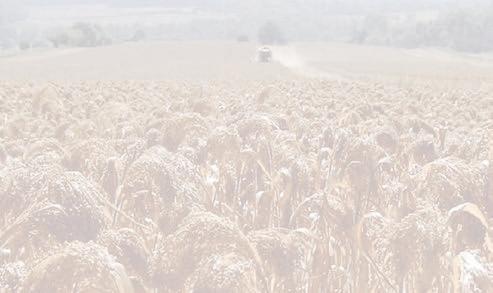

















• Flexible terms based on cash flow
• Reduce greenhouse gas emissions
• Remain profitable and sustainable
Farmers working to improve soil health can take advantage of a new loan agreement with preferential interest rates.
Launched by Oxbury Bank, the Transition Facility aims to help farmers continue farming profitably while changing their management practices to reduce carbon emissions and boost their resilience.

Available from an interest rate of 1% over the Bank of England base rate, the loan is versatile and can be used for any purpose. It can be drawn down and repaid continuously over period of up to six years.
Speaking at last month’s LEAF conference, Oxbury co-founder and managing director Nick Evans said the bank wanted to incentivise and reward farmers who made sustainable changes.
“Oxbury spent two years developing the Transition Facility ensuring that it understood the needs of farm-

ers and the supply chain,” he told the LEAF audience of farmers, industry leaders and academics.
“The bank concluded that the whole industry including government,

Nick Evans: meeting the needs of farmers
improving their soil health and boosting soil organic carbon.
Its launch follows independent research by the Soil Association Exchange showing that 77% of farmers who have decided to transition have little or no financial flexibility to adapt their farming systems.
With climate change pressures and demands from government and supply chains, Mr Evans said Oxbury recognised the need for farmers to obtain the necessary funds to change their farming practices.
The loan facility operates alongside other financing initiatives – including government grants and private sector payments for farming practices – creating a blended finance model to extend the impact of multiple partners in the value-chain.
Farmers already making changes
Borrow up to £500/ha – from £25,001 to £500,000
Interest rates from 1% above base for up to six years
Annual facility fees from 0.5% of the facility amount
Flexible repayment terms based on cash flow
Facility can be continuously repaid and withdrawn
Interest payable monthly on outstanding balance
No need to change your existing bank relationship
No early repayment charges
“ The industry needs to work together
will need to provide Oxbury with documentation showing what they have done. Farmers who are planning to make changes must provide budgets and other evidence for the changes to be made.
For full details about the Transition Facility, visit oxbury.com
As well as giving farms access to finance, the Oxbury Transition Facility helps farmers prove that any changes are delivering results.
Carbon footprints will be measured at the start of the facility and will be ongoing to assess reductions in emissions. Satellite imagery and soil testing will measure improvement in soil organic carbon levels. Oxbury has partnered with Downforce Technologies to calculate the annual average soil carbon levels across more than 120,000ha of farmland. This will
help farmers track the outcomes of transition actions on soil health.
While there are existing facilities for farmers to fund specific sustainable projects, Oxbury’s initiative allows farmers to take a range of actions over time and understands that the benefits will be gradual. Customers can use the facility in the way they deem most appropriate for their transition. This could cover for instance input costs, general working capital, infrastructure or machinery.
• Payments for organic matter test
• Increase in nutrient management
• More profitable farming practices
More farmers are taking advantage of Defra’s Sustainable Farming Incentive to better understand soil health.
Defra’s soil testing incentive CSAM1 is part of the wider SFI scheme and offers £6 per hectare and £97 per SFI agreement to farms willing to test the organic matter of soil on an annual basis.
Soil scientists say the incentive has spurred a sharp rise in laboratory tests – and led to more farms applying for the CNUM1 £652 payment to request nutrient management plans from FACTS certified advisors.
“Our labs in England and Scotland have been very busy,” says Eurofins Agro’s Shane Brewer. Many farmers are seeking to go a level deeper by learning more about the characteristics of soil, he adds.


The Eurofins fertilisation manager test measures the chemical values of macro and micronutrients, soil acidity and soil overall structure – alongside biological components such as fungi and bacteria.
Mr Brewer says: “We have seen growing interest in the Soil Life Monitor test which determines the total microbial biomass, fungi, bacteria and protozoa. It also identifies some physical characteristics such as pH and the quality of organic matter.”
A better understanding of soil structure makes it easier to judge which crops are better suited to both the soil and growing conditions. It also acts as an indicator for how well soil can retain water, explains Mr Brewer.
“Weather extremes can damage soil nutrient levels through leaching and leave soil less able to deal with rainfall. Testing soil each year helps to build a picture of how the soil is reacting to weather, crop choice and fertilisation decisions.”
Mandy McAulay, head of product sustainability at Origin Soil Nutrition, says more farmers are asking FACTS


certified advisors to create nutrient management plans under the CNUM1 option.







ter optimising organic sources, will produce a nutrient management plan that maximises nutrients and mini-


“Having soil samples that are no more than four years old is key to managing your nutrient usage more efficiently and effectively, says Ms McAulay – especially amid increasingly variable weather from season to season.


“Knowing the expected yield and crop offtake, and calculating the nutrients required af-







Farmers are being reminded to comply with Sustainable Farming Incentive rules – and make sure they can show there are meeting their obligations.
Growers and livestock producers who sign up to the SFI could face a hefty penalty if they are later unable to show the Rural Payments Agency they are meeting its full requirements, say farm business consultants Strutt & Parker.
One of the simplest SFI actions is to assess soil, produce a soil management plan and test soil organic matter (CSAM1). The assessment must be carried out and a written soil management plan produced within 12 months of an agreement start date. Schedule in your soil tests over the course of your agreement, so you meet the requirement that

Growers and agronomists keen to optimise margins are using the combination of more regular soil testing and detailed nutrient management planning to improve soil health whilst reducing input costs.


within the last five years all land parcels have had their soil organic matter measured.
Without a reminder in the diary, it can be easy to forget which land parcels need soil tests in years two and three of the agreement. Growers should also check that any old soil test results you may be relying on actually include soil organic matter – not all do. The soil management plan should be reviewed each year.
Requirements are similar for nutrient management plans (CNUM1). As with the soil management plan, the nutrient management plan needs to be completed within the first 12 months and then reviewed each year.
The nutrient management plan must, however, be completed by a FACTS-qualified adviser. This means that an existing management plan for the Red Tractor scheme may not be adequate.



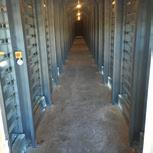





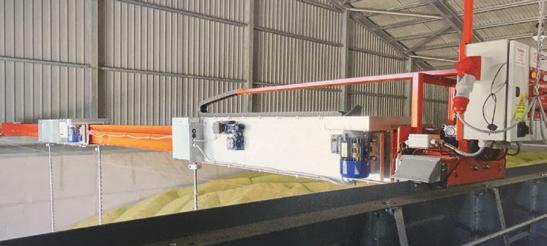







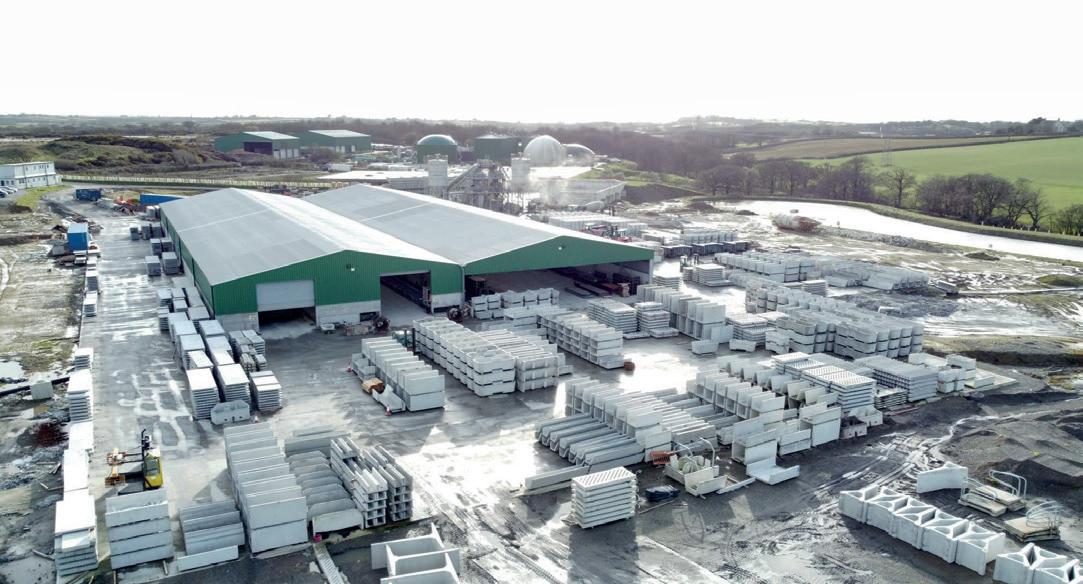

• Sodden soils after another wet winter
• Test properly to assess nutrient status
• Take time before drilling spring crops
Growers in doubt about the nutritional status of soils this spring should get out in the field and conduct a thorough test, says an agronomist.
ProCam agronomist Justin Smith says there’s no room for complacency when managing this season’s mixed bag of forward and backward crops after another wet autumn caused a wide drilling window.
“There’s no better way to understand the nutritional status of soils or needs of a crop than by testing. Likewise, there’s no substitute for using a spade to dig a hole to determine if or when soils are ready to be drilled.”
Soil testing and tissue sampling



will help determine nutrient requirements, says Mr Smith. “Rather than mauling in spring crops, growers should take the time to make sure conditions are suitable, he adds.
“It might be tempting to drill spring crops at the first sign of drier conditions, but after such a wet winter don’t underestimate just how waterlogged the ground could remain, especially where soils were compacted.
“Likewise, when we get to next autumn’s drilling window, be patient. It’s never too early to start planning, so talk to your agronomist about whether you should be thinking about sub-soiling or ploughing to alleviate compaction.





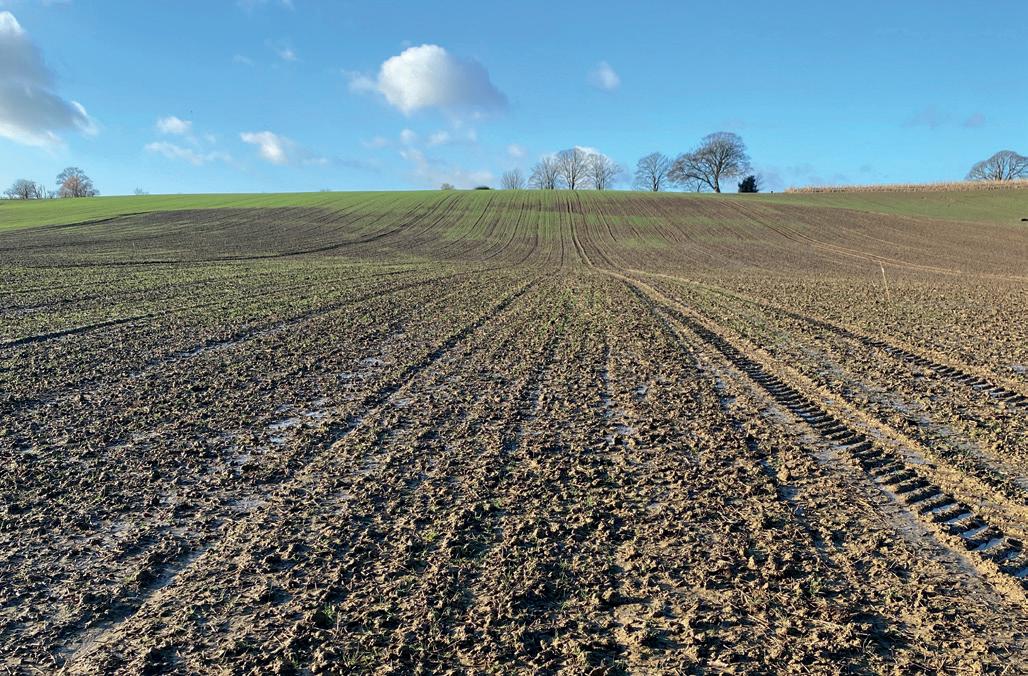












“But be prepared to change plans as the year unfolds. If conditions aren’t suitable for deep cultivation work, any good intentions could easily backfire and put soil structure and yield potential even further back.”
A flexible approach will pay dividends following a wet winter, says Mr Smith. Although some crops are very for ward, some are less advanced and oth ers are way behind where they should be at this time of year.
“While some crops were successful ly sown in early September, wet weath er soon halted progress, resulting in crops being drilled in two or three dis tinct phases several weeks apart.”
With such a diversity of situations, a blanket approach to crop care won’t suffice. Growers are therefore advised to seek specialist agronomic support to guide them on a case-by-case basis.
“In a lot of cases, reserves of resid ual nitrogen will have been depleted by the wet conditions with crops in need of an application of fertiliser as soon as possible. As well as conventional fertilisers, growers should consider alternative nitrogen sources.”
Encera, a bacteria-based product which fixes atmospheric nitrogen and makes it directly available to the plant, provides an accessible source of nitrogen while offsetting the cost and logis-












Weed control will require a tailored approach, says Mr Smith. “Where a pre-emergence herbicide was successfully applied on time and there was plenty of moisture available to aid uptake, the weed burden hopefully won’t
"But where pre-em treatments were hampered or missed entirely, a robust approach will be needed in the spring. Again, an experienced agronomist’s advice will be crucial to ensure each field and crop is protected according
The priority for very forward crops will be to manage canopies to prevent lodging later in the year, with the application of a PGR such as trinexepac and prohexdione in Medax Max also providing a useful secondary benefit by stimulating root development.
“Disease burden will also vary greatly depending on the crop’s status, with any that were drilled early likely to need a T0 treatment to keep ahead of infections such as Septoria,” explains


































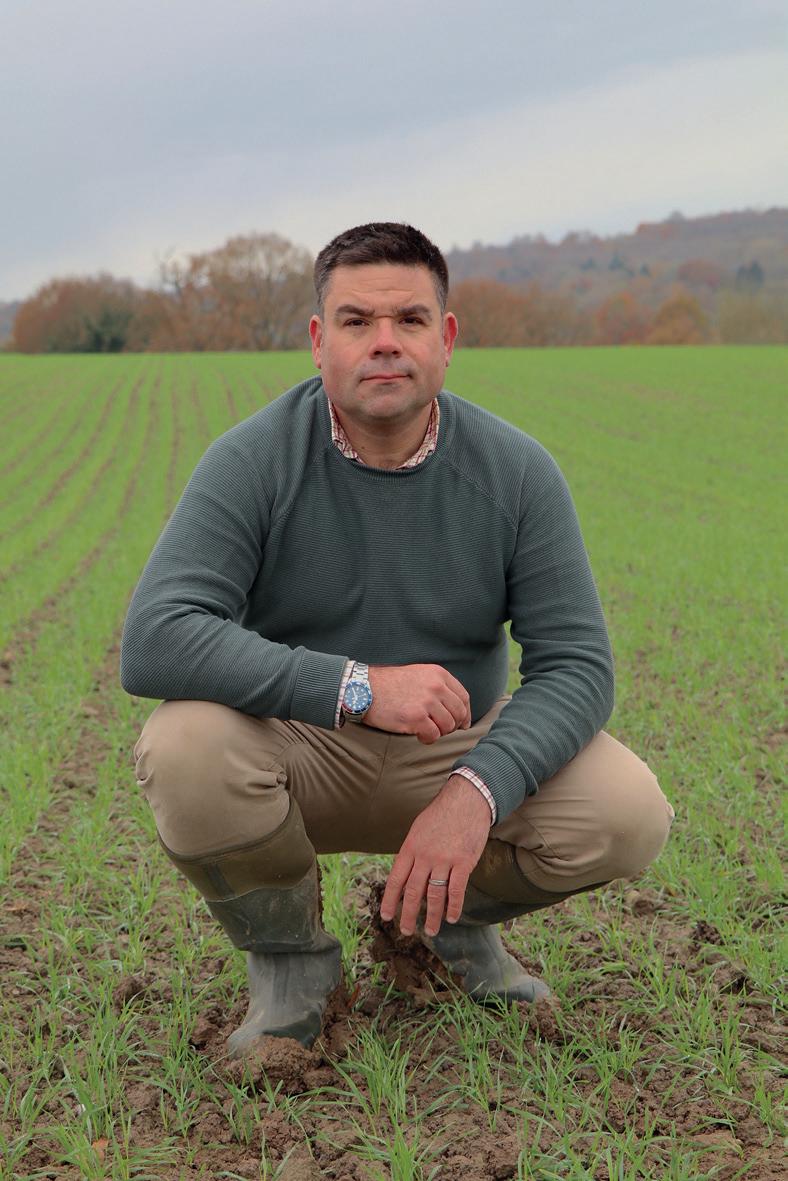


























































More than 70 farmers attended the inaugural client conference held by independent agronomy firm Indigro last month.
Believed to be the largest one-day event of its kind by a UK-based independent agronomy company, the conference took place on 4 February at Whittlebury Hall, Northamptonshire.
The day was themed around farm resilience. A packed and wide-ranging agenda covered subjects as diverse as soil health, sap testing and gross margins – and ways to integrate the Sustainable Farming Incentive within the farm business.
Technical sessions looked at varietal choice, appropriate disease control, weed management, regenerative practices, biodiversity net gain and soil carbon management – including revenue potential.
With a theme of Fit for the Future, the day concluded with an after-dinner speech from agronomist Sean Sparling, executive director and former chairman of the Association of Inde-
pendent Crop Consultants.
Indigro director and co-founder Roger Davis said: The aim of the conference was to update and engage our clients about critical issues in today’s challenging times and make them and their farm businesses more resilient.
“The conference provided truly independent advice on a broad spectrum of subjects to improve farm profitability and the quality of the food we produce, whilst also improving the health of soil and water and natural capital.
Positive discussion
Mr Davis said the event was well-
Econometric chief executive David Wright takes the stage
The inaugural agronomy conference was themed around resilience

Aregenerative farming initiative started by commodity trader ADM has exceeded expectations thanks to solid support by farmers, says the company.
ADM’s regenerative agriculture programme encourages farmers to implement practices that help to improve soil health and water quality, promote biodiversity – and curb carbon emissions.
More than 260 farmers enrolled on the programme in its first year. They receive payments for using regenerative farming methods and technical support on how best to implement these practices on their farm.
"Farmers understand the important role regenerative agriculture plays in securing the future of their businesses and the planet," says Jonathan Lane, managing director of ADM Agriculture.
"ADM is committed to supporting farmers in our effort to create a more
sustainable and resilient food system, and our UK experience gives us confi dence as we seek to continue to scale up our efforts globally."
The global company defines regen erative agriculture as an outcomebased farming approach that protects and improves soil health, biodiversi ty, climate and water resources while supporting farming business develop ment.

attended, fostering healthy and thought-provoking discussions. Feedback was overwhelmingly positive, he added, and Indigro was delighted with the level of debate.
Indigro offers cropping advice for all the main arable, root and pulse crops – as well as specialist planting on both arable and mixed enterprises –across the Midlands, East Anglia and south-west England.
The company conducts its own trials and research analysis to ensure our customers receive the most up to date information. Crop and soil management advice – ranging from cultivation systems to regulatory advice and carbon management.
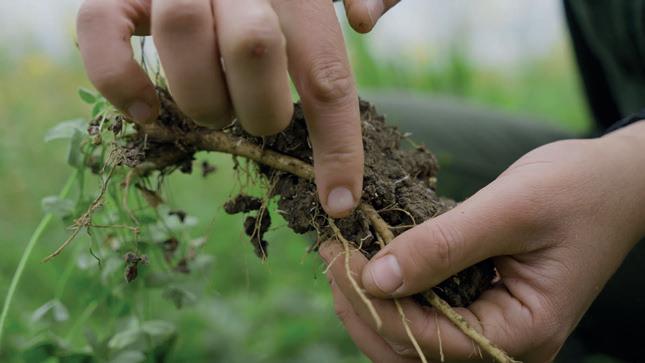
After expanding from North America to Europe last year, ADM's global regenerative agriculture programme targeting 1.4 million hectares in 2024. It is now targeting 2 million hectares in 2025.
Globally, ADM says the initiative reduced its Scope 3 greenhouse gas emissions and delivered carbon dioxide sequestration that was equivalent to removing more than 135,000 cars from the road for a year.
The scheme rewards farmers who improve and maintain soil health
ADM works with key implementation partners offering remote data collection and validation to give farmers a deeper understanding of their carbon footprint and sustainability performance.
The UK programme was designed with farm data specialists Map of Agriculture – giving ADM customers crucial insights into the environmental impact of their supply chains, including verification by techniques such as remote sensing.
For more details about the scheme, email ClimateSmartuk@adm.com.
































































Defra plans to review the way it funds flood defences – saying it wants to ensure that farms, rural businesses and local communities are properly protected.
It comes after the government unveiled an extra £50m for internal drainage boards (IDBs) – the public bodies responsible for managing water levels for agriculture and the environmentin low-lying areas.
Defra says the investment will put drainage boards on a firm footing to deliver their vital role in flood and water management. IDBs that submit successful bids will be able to spend the £50m on projects over the next two years.
This will benefit projects that will improve, repair or replace IDB assets – including flood barriers, embankments and maintenance of watercourses. Defra says the funding will support projects which reduce the risk of flooding and its impact.
Defra minister Emma Hardy said the extra funding would benefit farmers and rural communities – and would be accompanied by a government consultation on a new strategic vision for floods investment.
The funding formula for allocating money to proposed flood defenc-
were destroying homes, businesses and livelihoods across the country –with farming communities facing the heaviest consequences, she warned.
“That is why this government is reforming how flood funds are distributed to protect businesses, rural and coastal communities as we invest over £2.4bn in flood defences across the country.”

es would be simplified to new flood schemes could be delivered more quickly – including innovative approaches such as nature-based schemes and sustainable drainage.







A government consultation this year will include a review of the existing formula to ensure the challenges facing businesses and rural and coastal communities are properly accounted for when delivering flood protection, said Ms Hardy.
More intense weather events


Farmers are being encouraged to join forces and find new ways of securing enough water for agriculture.
Although increased reservoir storage is likely to feature prominently, the Environment Agency is encouraging groups of farmers to think “outside of the reservoir box” and look for more innovative solutions.
Water Resources East is being funded by the agency to provide technical advice and input to consultants and fam clusters. It follows an open application process for groups of farmers to work in clusters to improve water resilience. Potential new options include new water



A new Floods Resilience Taskforce met for the first time last autumn –bringing together central and local government representatives, the NFU and others to discuss ways to speed up and co-ordinate flooding preparation and resilience.







Association of Drainage Authorities chief executive Innes Thomson said the additional funding would “go a long way” to ease the pressure on internal drainage boards facing the significant cost burden from winter


storms.”

sharing arrangements, water rights trading, increased utilisation of high flow abstraction, floodplain storage and collaborative working with Internal Drainage Boards.
Grants are potentially available from Defra to meet 40% of the construction costs of options under this process. Options will likely need planning approval and Environment Agency consent if they require new abstraction licences.
Other developments include the formal incorporation of Water for Food as a national voice for agricultural water needs – and an opportunity to grow a network of water abstractor groups (WAGs) between Lincolnshire and Essex.
How Northants farmers are helping to reduce flood risk for neighbouring communities using natural solutions.
Tristan Baxter-Smith reports
As a fifth-generation farmer, I know unpredictable weather is nothing new, but 2024 was on another level. It was the wettest 18-month period since records began, and we all felt the impact: sodden fields, waterlogged crops, impassable roads, and, for many, the devastation of floodwater entering homes and businesses.
Like many farmers, I’ve spent my fair share of time clearing ditches, helping neighbours pump out water, while trying to protect my own land from flooding. But as storms intensify and flood risk increases, we need longer-term solutions that work with nature, not just emergency responses.
That’s where Natural Flood Management (NFM) comes in - and why the RAIN Project is working with farmers and landowners across Northamptonshire to deliver funded flood resilience projects.

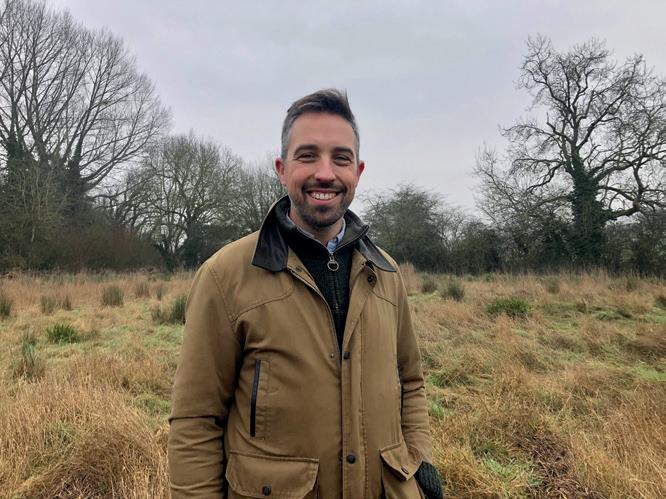
A Science-Backed Approach to Flood Management: The RAIN Project, funded by Defra’s Flood and Coastal Resilience Innovation Programme, is helping landowners and farmers implement practical, land-friendly flood management solutions.
What makes this different from past
approach, we’re targeting the most effective locations to slow water flow and reduce flooding downstream. And
the best part? There’s funding available to compensate farmers for land used in these projects, so flood mitigation can be part of a sustainable farm business.
Tristan Baxter-Smith is Land Advisor for Nene Rivers Trust & NFM Lead for The RAIN Project.

We are supporting farmers in implementing practical, landfriendly flood management solutions, including:
1. Tree and Hedgerow Planting Trees and hedgerows absorb excess water, reduce erosion, and slow runoff. They also act as windbreaks, improve soil stability, and offer shelter for livestock and wildlife.
2. Wetland Creation
One of our biggest projects will be the development of a new two-hectare wetland north-west of Brigstock. This site will hold water higher in the Harpers Brook catchment during periods of heavy rain, reducing flood
risk for villages downstream, including Sudborough and Lowick. Wetlands act as natural sponges, storing and gradually releasing water while creating valuable habitats for wildlife.
3. Leaky Dam Features
Leaky dams in streams and ditches slow water flow, helping to prevent erosion, store stormwater, and create more resilient watercourses.
4. Soil and Land Management Changes
Adjusting soil management such as cover cropping, reduced tillage, and contour ploughing, improves water infiltration and reduces runoff, leading to better soil structure and increased yields.
Funding Support for NFM Projects
We know land is a farmer’s most valuable asset, so RAIN provides funding to compensate farmers for land used in NFM projects. This means financial support to offset temporary income loss, and in some cases, new revenue opportunities.
We’re actively looking for more farmers to partner with for projects in the Harpers Brook and Wootton Brook catchments. Get in touch. By working together, our aim is to help reduce flood risk, while at the same time boosting your local natural environment - all while making sure that farming businesses continue to thrive. www.rainnorthants.co.uk RAIN@westnorthants.gov.uk




































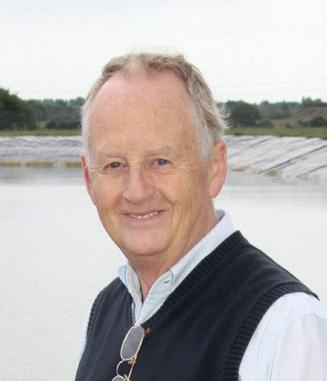
Farming must address the twin challenges of food and water security, says Melvyn Kay .
“Water, water everywhere, nor any drop to drink,” wrote English poet Samuel Taylor Coleridge in The Rime of the Ancient Mariner. Penned in 1798, it's a sentiment that echoes down the ages as water becomes an increasingly scarce resource today.
With so many issues facing UK farmers, there is seldom an ideal time to talk about water for agriculture. Yet we are experiencing increasingly frequent winter floods – often followed by summer droughts.
Each of these extreme weather events can have a devastating impact on food production – especially when they occur at the wrong time and in the wrong place. Dealing with all this gets more complicated by the day.
Many farmers understandably think they have adequate access to water. That may be true now – but it may not be true in the near future. The sector is under increasing pressure – and not just from the weather.
Many growers seem unaware of the potential licence cuts coming down the track as the Environment Agency continues to review abstraction licences in an effort to balance future water supply and demand in key catchments.
UKIA Conference • 5 March • Peterborough www.ukia.org
Why farmers are the best people to manage water for agriculture
When I ask farmers whether they realise the serious implications this has for their businesses, many are unaware. Understandably, the current economc climate means they are hard-pushed to think about the future.
But the Environment Agency does think long-term. And so do the five regional water planning groups, which are responsible for bringing together water plans from England’s 17 water companies.
They are asking what the aquatic environment will look like in the 2050s. Will we have enough water? And if not, how do we avoid a water crisis? For this reason, these groups are taking action now to reduce abstraction so we will have a sustainable environment in the future.
How are farmers responding? Some in the most critical water-short regions are already facing licence cuts and some have had licences revoked. Others are preoccupied with other here-and-now issues.
Still others are joining force and working together in Water Abstractor Groups (WAGs) to tackle common problems. Some WAGs are well established in the Anglian Water region with more at an embryonic stage.
Last summer the Environment Agency called for small groups of farmers to apply
the past six months or so, 19 screening studies have seen 100 farmers working together to test this appoach.
The results are encouraging. Farmers are getting together as WAGs, increasing their awareness of the challenges they face, discussing them and looking for local potential solutions.
The outcome from the screening studies – including next steps – will be a central theme for the UK Irrigation Association Conference on 5 March at the Orton Hall Hotel, Peterborough.
Traditionally, regional planning groups only focused on planning for public water supply. But this is changing because Environment Agency funding means they can take account of water for agriculture as they plan the next National Framework.
Agriculture now has a seat at table in terms of the planning process including representatives at a national level from the Water for Food Group and the NFU. New appointments are now in place in five regional planning groups.
As each region is different, each has developed their own approach – reflecting their structure, development and regional needs. It all means things are beginning to look up for farmers and water.
Melvyn Kay is executive secretary of the UK Irrigation Association. For details, visit www.ukia.org
New book out now
Sustainable Development and Water Security
Towards achieving a water-secure world
Melvyn Kay and Olcay Ünver
£29.99 at www.agendapub.com and Amazon ISBN 9781788217538




Irrigation and weather start-up
Sencrop has been acquired by Groupe ISAGRI – one of Europe’s leading companies in digital solutions for field management.
The acquisition aims to ensure the continuity of innovation and provide farmers with higher service levels, moving Sencrop from a fledgling com pany to being part of an established service provider, says ISAGRI.
Sencrop co-founder Michael Bru niaux said the partnership came at a crucial time when pressure on farm margins and the impact of climate change were forcing farmers to re think the way they manage their busi nesses.
With a fast-growing weather commu nity, users and their partners – includ ing co-operatives and traders – would
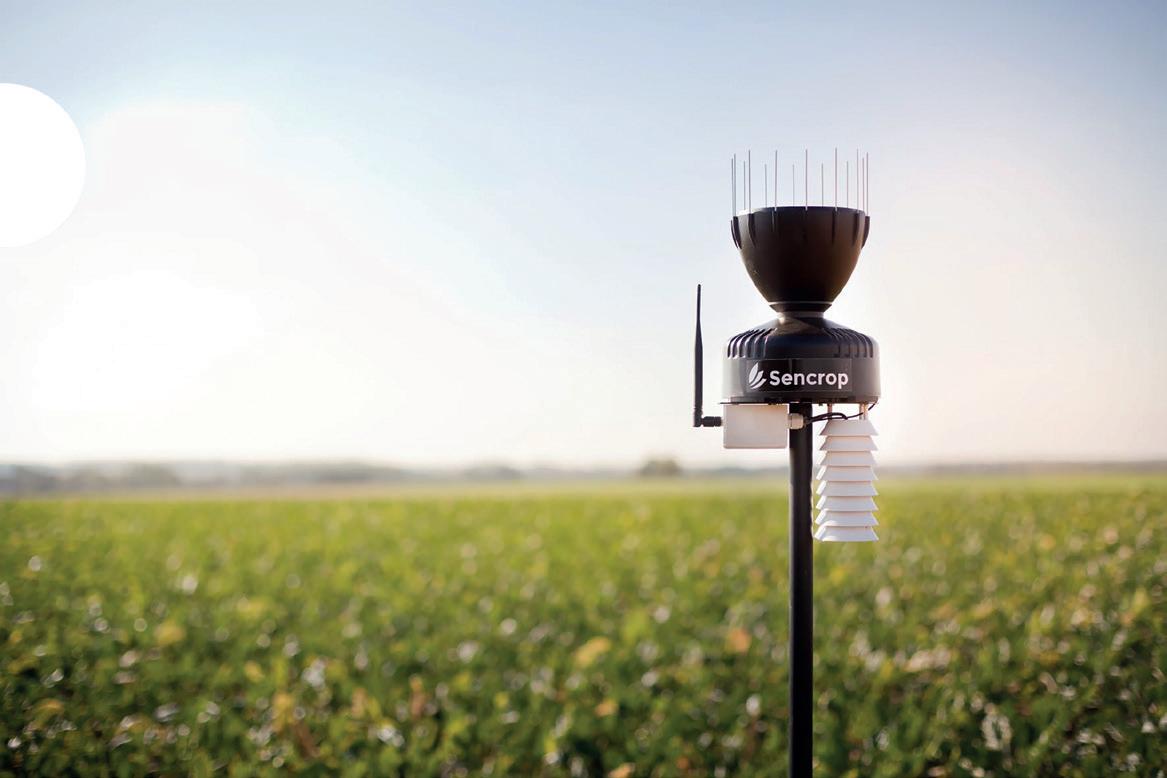


term viability of the network in which our customers have invested, guaranteeing the presence of a solid partner who will listen to their needs, and provide them with appropriate solutions.”
ISAGRI's Horizon 2028 project, which aims to make the company a global technological leader in connected agriculture. The acquisition of Sencrop is seen as a key step towards this goal.
For farmers, using weather data to act at the right time is becoming increasingly important. This includes when drilling, irrigating and harvesting crops – all of which can make a significant difference to crop yields.
“This move comes at a time of consolidation in the ag-tech sector, and ISAGRI is the ideal partner to accelerate the development of our unique collaborative platform,” said Sencrop co-founder Martin Ducroquet.
“We have strong synergies which will bring about the emergence of tomorrow's leader in precision agriculture, where data and artificial intelligence will play a key role.”
Asolar powered irrigation monitoring system was named Digital Innovation of 2025 at this year’s LAMMA machinery show.
Raindancer is a GPS-enabled system designed to maximise water efficiency for farmers. It uses sector control technology to ensure irrigation is applied only within field boundaries, avoiding wooded areas and other non-crop zones.
By accurately distributing water across the crop and addressing typically under-irrigated areas, the system optimises irrigation performance – helping to optimise enterprise margins.
Developed over four years, including two years of in-field software and app refinement, the system delivers precise insights on irrigation runs. It tracks how much



• Booms for lane widths 10 - 96 metres
• Hosereels from 150 - 750m pipe length
• Motorpump range; flow rates 30-150m3/hr

• Raindancer remote monitoring & control
• Fixtures, fittings, pipework and more... visit our website: briggsirrigation.co.uk call us on 01536 260338 or email: enquiries@briggsirrigation.co.uk

water has been applied and alerts users to faults, ensuring smooth operations.
Manufactured in Berlin and exclusively imported to the UK by RST Irrigation, Raindancer integrates with the accompanying gun sector for enhanced performance. The award was announced ahead of the LAMMA event at the Birmingham NEC.
With over 3,000 Sector Control units sold in the past two years, RST Irrigation says Raindancer has proven its value. Ongoing software development and app enhancements promise to further streamline its usability and functionality.
By reducing water waste and improving irrigation efficiency, Raindancer supports sustainable agricultural practices, helping farmers to conserve water resources and enhance productivity.







• Abstraction licence terms breached
• Offences took place over four-year period
• Magistrate imposes £4000 fine
Farmers are being reminded to abide by abstraction licences after a Norfolk grower was fined more than £4000 for taking too much water.
Brian Rutterford, 77, of Undley, Lakenheath, was ordered to pay £4300 on 15 January at Norwich Magistrates Court. It followed water abstraction offences over a four-year period involving a channel next to his farm in Hockwold-cum-Wilton.
The court heard that Mr Rutterford took three times the amount of water permitted by his abstraction licence. He continued to take water during the record-breaking hot summer of 2022, when the region was in drought.
The successful prosecution was brought by the Environment Agency. It said Mr Rutherford had a history of environmental offending and his actions affected water supplies for the local community.
Mr Rutterford held two water abstraction licences – one for summer and one for winter. His licences required him to keep abstraction records and maintain abstraction meters – but
Mr Rutterford argued that he over-abstracted the water to address a leak in his lake that put his fish at risk. But prosecutor Mrs Sarah Dunne told the court that his activities had continued for four years including during a summer drought.
In addition, the water abstraction offences were committed while Mr Rutterford had received a suspended sentence for another separate environmental offence involving the operation of an unpermitted waste site at his farm.
Mr Rutterford pleaded guilty to over-abstraction under both his licences between 2018 and 2022. The presiding magistrate said he had been “chaotic” and “incompetent” – and his previous offence was an aggravating feature.
The court ordered Mr Rutterford to pay a total of £4,300. This included a £2000 fine for his offences, £100 for breaching his suspended sentence, £2000 prosecution costs and a victim surcharge of £200.
Environment Agency water resources specialist Michelle Herron said: “Abstraction licenses are issued to ensure that there is enough water for everyone and that there is no harm to the environment.
“Water abstractors have a responsibility to conserve supplies, especially during droughts. Mr Rutterford clearly failed in fulfilling his responsibilities, so it is right that he pleaded guilty


summers will be ‘enormous challenge’
The Environment Agency says it will continue to carry out robust regulation and enforcement on those who break the rules.
Drier summers will be an enormous challenge over the next few decades, so building drought resilience is important, says the agency. The licensing system protects water resources by controlling how much is abstracted, where and when.
Norfolk farmer Brian Rutterford had two water abstraction licences which allowed him to abstract water from the channel next to his Black Dyke Farm. Under his winter licence, he was permitted to abstract a limited amount of water to fill a lake at his farm.
Under the summer licence, Mr Rutterford was permitted to abstract a much smaller amount and only for the purpose of crop spraying. Conditions on his licences required him to keep abstraction records and maintain abstraction meters.
Mr Rutterford pleaded guilty to over-abstraction under both licences between 2018 and 2022. He also pleaded guilty to failing to maintain abstraction records in accordance with his licences and failing to maintain and calibrate his abstraction meters.
Anyone taking 20m ³ of water or more daily is required to have an abstraction licence.
Where abstraction is damaging the environment, the agency also has the power to amend or revoke existing licences.
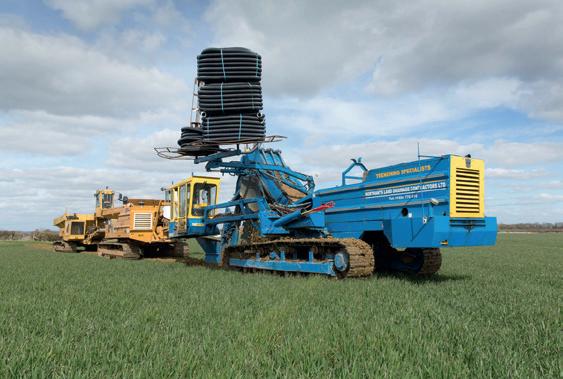
Equipment - Livestock - Feed - Fertiliser - Seed - Cash Flow
Equipment - Livestock - Feed - Fertiliser - Seed - Cash Flow
Diversification Projects - Building - Debt Consolidation

•
•
•
- Fertiliser - Seed - Cash Flow Diversification
jects - Building - Debt Consolidation

• Decision within 24-hours
• Bad credit history, large debts... No problem!
• High street banks unsupportive
• Tenant farmers welcome




We bring the personal touch back into farm finance. For the personal touch, ring George Bridgman on 07522 731193 george.bridgman@abfltd.co.uk






























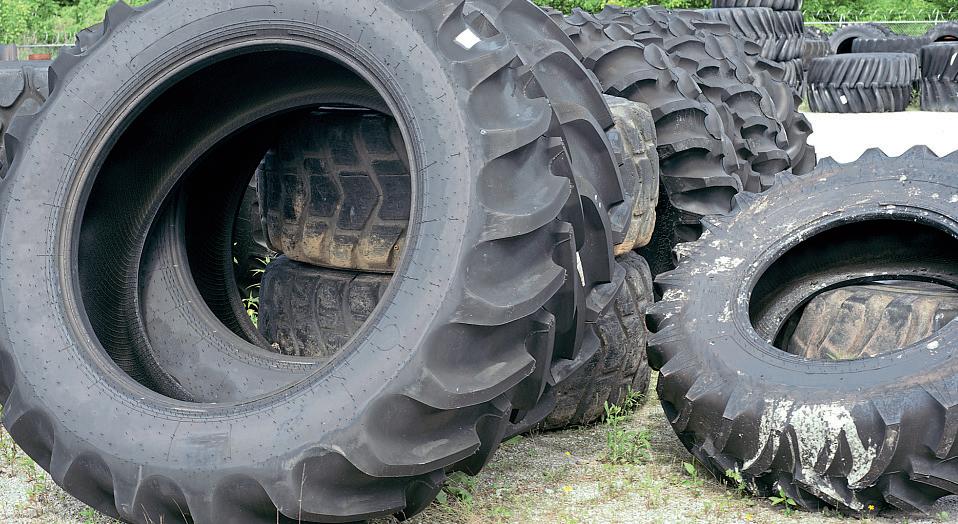

































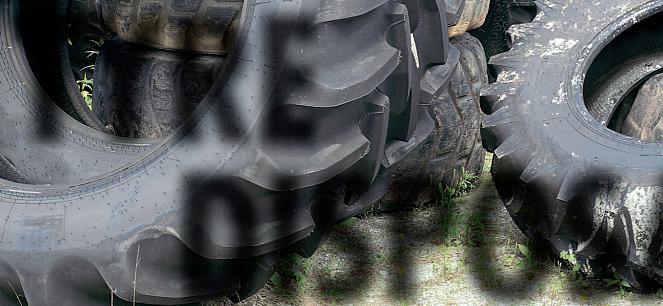





















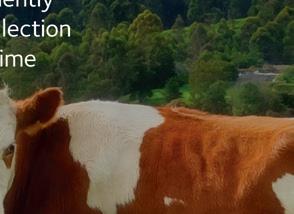
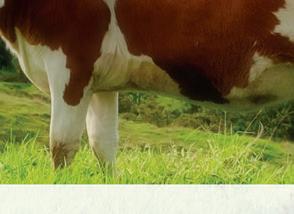









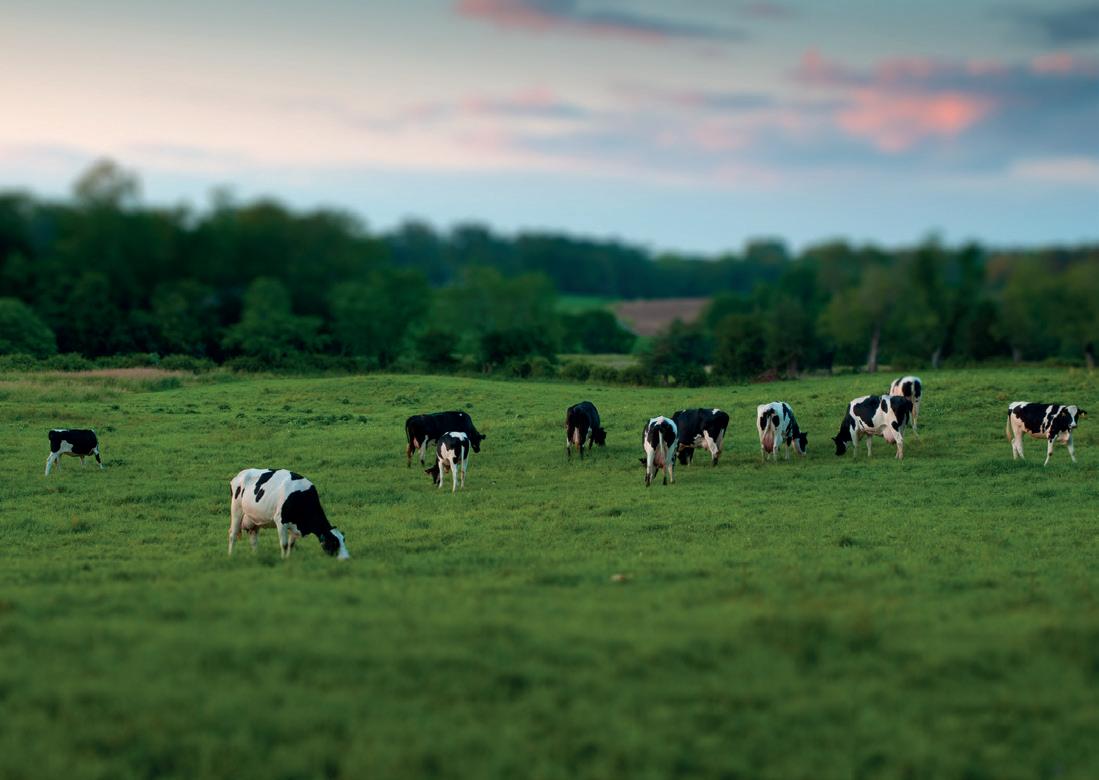
• Deadweight prices reach record highs
• Domestic production expected to fall
• Tighter supplies meet higher demand
Beef prices are expected to remain firm this year – although imports are expected to rise to compensate for a fall in domestic production.
UK beef production is expected to decline by 5% year-on-year to 885,000 tonnes in 2025, according to the latest figures from the Agriculture and Horticulture Development Board. At the same time, beef consumption is forecast to grow by 1%.
Famgate beef prices have reached record highs in recent weeks. The average all-prime price reached 620p/kg during the week ending 13 February – an increase of 15p on the previous week and 125p higher than the same time last year.
The drop in UK production follows a sustained reduction in cattle numbers due to a combination of factors – including underlying business profitability and the phase-out of direct payments.
Prime cattle availability is forecast to decline, with a 6% drop in prime cattle slaughter to 1.99 million head. Reductions in cattle supply are also expected to continue into 2026, following trends in calf registrations in previous years.
AHDB red meat analyst Hannah Clarke said: “The beef sector is entering a period of significant supply constraint – which is expected to support cattle prices throughout the year.”
Beef mince is expected to perform strongly in the retail sector. But price sensitivity to more expensive cuts and consumer choice will play a pivotal role in determining overall carcase values, says the AHDB.
Having said that, consumer concern about ultra-processed foods is
expected to fuel demand for fresh, primary beef cuts over processed prod ucts. Some 90% of consumers believe that diet is important in contributing to their overall health.
Overall, consumer demand for beef is forecast to grow by 1% year-on-year. While that is good for producers, on the trade front, UK beef imports are expected to rise by 12% to compen sate for lower domestic production.
Cattle numbers are set to tighten further this year
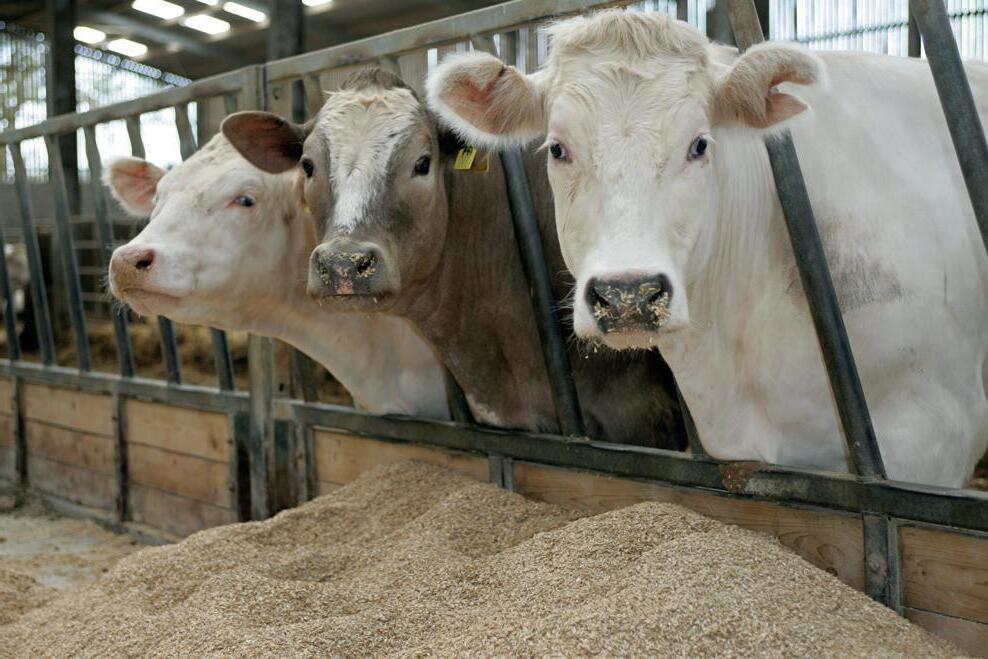
Imports from Ireland, the UK’s largest supplier, are likely to see the most significant increase. And the AHDB expects beef exports to fall by 7% in 2025, pressured by supply constraints after strong growth in 2024.
Farmgate cattle prices are expected to be supported, with reduced supply both domestically and globally likely to drive competition for beef cattle – and retailers continuing to promote beef.
“The supply chain will need to focus
“
perform strongly
“Communication around the nutritional benefits of beef, as well as continued emphasis on sustainability and animal welfare, will help to secure long-term consumer trust and demand for beef.
“As the industry heads through 2025, the UK beef sector will need to stay agile in responding to market shifts, with a focus on driving efficiencies and engaging consumers through compelling messaging and promotions.”
Farmers can ask their vet to blood test sheep for exposure to toxoplasmosis and enzootic abortion – thanks to the 2024 FlockCheck scheme.
Launched by MSD Animal Health, the scheme opened last month, with the EAE diagnostic phase starting on 1 April. The subsidised service, which helps identify possible reasons for early lamb losses, closes at the end of June.
Ewe reproductive failure, neonatal lamb disease and mortality are the three biggest factors limiting better flock productivity – with toxoplasmosis and enzootic abortion significant causes of these unwanted flock heath issues. Consequently, sheep farmers who find that
more than 2% of their flock is barren or aborting this lambing season are being encouraged to contact their vet to take advantage of the FlockCheck diagnostic scheme.
More than 30% of GB sheep flocks don’t know their barren ewe rate or are reporting a figure greater than 5% after lambing, said MSD Animal Health veterinary adviser Kat Baxter-Smith. “This is particularly concerning.”
Sheep producers can take advantage of the FlockCheck scheme by asking their vet to take blood samples from six to eight aborted, unvaccinated ewes – or from barren ewes or ones that have produced weakly lambs.
Results help vets and farmer make more informed decisions about appropriate flock health measures, says MSD.
Feeding cold milk to surplus lambs makes no difference to growth rate – and can ease the workload during a busy season, suggests a study
Some 58% of survey respondents said they will consider feeding milk replacer cold to surplus lambs this season – and view the method as a viable alternative to feeding warm milk during the busy lambing period.
In a separate question, over half of respondents said feeding milk replacer cold to lambs made no difference to lamb growth rates and could be advantageous for feeding lambs at different growth stages.
‘Proven technique’
The data comes from the annual Lamlac Lamb Intentions Survey carried out at the end of 2024. Ewe milk replacer fed cold was a proven technique – and provided surplus lambs with the consistent rearing support they require, said the company.
“Rearing surplus lambs with milk replacer fed cold offers sheep producers a time-effective feeding method in
their systems,” says Lamlac sheep nutrition expertJessica Cooke.
“After following recommended rearing practices during the first week of life, the ability to feed cold can help in situations when rearing lambs of different ages requires milk to be fed at a constant temperature.”
The survey findings are supported by trials at Reaseheath College, says Dr Cooke. Lambs fed cold milk achieving a daily live weight gain of 0.27kg/ day, compared with the 0.25kg/day delivered by the warm milk fed group of lambs.
“Lambs fed cold milk replacer from just over a week of age showed no negative impact on their performance,” says Dr Cooke. “In fact, lambs fed cold milk replacer performed marginally better through to weaning.”
Feeding milk replacer cold shouldn’t be seen as poor alternative to warm milk feeding –and can add flexibility to lambing systems. General rearing advice shouldn’t be any different to feeding warm milk replace,
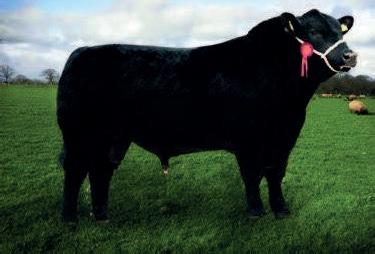

performed marginally better
Producers feeding cold milk replacer should always mix cold and feed –rather than mixing warm and allowing to cool – to avoid gorging.
Celebrating 96 years in business 1924-2020







• Waterproof
• Safety toecap
• Nail Stop midsole
• Super comfort and weight saving
• Sizes 6/40 to 13/47


• Waterproof
• Safety toecap
• Nail Stop midsole
• Ankle impact protection
• 360º Reflectivity
• Super comfort and weight saving
• Sizes 3/37 - 13/47



• Waterproof
• Non-safety spec
• Pull-on lever openings
• 360º Reflectivity
• Super comfort and weight saving
• Sizes 3/37 to 13/47




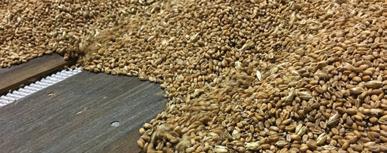
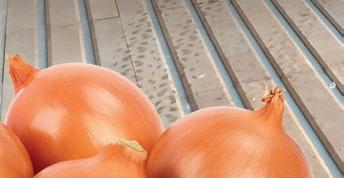















Following last month’s article on optimising forage, this month we focus on selecting a compound feed to complement your forage analysis, writes Nerys Wright
Seasonal variations in forage quality mean the same compound feed and quantities may not be suitable in every situation every year.
In years with good winter forage, we can reduce purchased feed. Conversely, when forage quality is poor, supplementary feeding ensures ewes meet their energy and protein needs.
Shop around
Compound feeds vary significantly between and within companies. Generally, you get what you pay for. If one option is £10/tonne cheaper, it probably contains ingredient substitutes. It's advisable to shop around for quotes and options.
With that in mind, key elements to consider are energy and protein – in that order.
Feed companies are not legally required to disclose the energy content of their feed, which is measured in ME/ kg dry matter (DM). But you should still ask your supplier – and a good one will have no problem telling you.
Compound feed energy content should be higher than the energy of your forage – otherwise there is little point feeding it. Protein content – as a percentage – should com-
Check the label – ingredients are listed in descending order.
Cereal content – wheat and barley at around 20% will be high in ME, while wheat feed is lower quality.
ME should be greater than 12 MJ/kg DM.
Protein content should be 18-20%, with around 5% DUP.
Fibre content should be less than 10% since fibre is obtained from forage.
plement your forage and do find out the ingredients.
You should also ensure the feed contains rumen degradable protein (RDP) and digestible undegraded (DUP), with DUP being essential in the last 3-4 weeks pre-lambing for twin and triplet-bearing ewes.

Be cautious not to overfeed ewes in the last six weeks pre-lambing. This can lead to larger lambs at birth and potential lambing complications. Increasing feed allowance for ewes in the run-up to lambing will support udder development and lamb growth.

But I would advise against feeding more than 1kg of feed per day. I also recommend splitting feeds into por-


This helps maintain rumen pH stability and optimises forage digestion.
Nerys Wright is an independent sheep consultant. For more details, call 07891 187643 or visit sheepconsultancy.co.uk.















• Helps improve flock management
• Easy to operate strict culling policy
• Integrated farm assurance scheme
State-of-the-art data management is helping an organic sheep producer run a more efficient flock.
A strict culling policy and close monitoring of lamb weights during the finishing period are the keys to success for Sam McPherson, who is in a shared ownership agreement at Sezincote Farms, part of the Sezincote Estate, in Gloucestershire.
Mr McPerson looks after the estate’s 1,000-ewe flock, comprising 600 pedigree Lleyns and 400 Lleyn x Texels, near Moreton-in-Marsh. Data technology has played an integral role in flock management since he joned the 2800ha farm five years ago.
Below: A software subscription was included with the handling system
Low input system
Sheep at Sezincote are run in an outdoor lambing system, which runs for about four weeks from 8 April. All lambs are finished on the farm and sold mainly to Dunbia at an average deadweight of 21-22kg.
In addition to the main flock, a group of 150 ewe hoggs is lambed each year and put to an Innovis Primera tup – a composite meat sire developed in New Zealand.
“We run a hard culling process to try and make it all as easy as possible,” says Mr McPherson. “Anything that goes lame or has any lambing problems will be culled; we can’t have any stragglers in the system.”
We can’t have any stragglers “

Mr McPherson runs his own Texel flock separate from his Sezincote commitments – and he was responsible for introducing the breed to the estate’s flock to produce lambs which finish faster.
“We finish all lambs on grass leys –including a mix of red clover and chicory – and a roots mix of vetch, oats, fodder rape, radish and turnips. Crossbred lambs are generally gone by October, and pure lambs are finished in time for the next lambing.”
Mr McPherson uses iLivestock data management technology. A year’s subscription to the company’s livestock software was included in the purchase of Mr McPherson’s Alligator sheep race and handling system.

He says he was so impressed by the software that he continues to use the accompanying eWeigh weigh head as a paid customer today.
“The app has a flag system – very useful when deciding which ewes to keep and which to cull.”
Being able to record information on various selection criteria is an invaluable selection tool. This includes the ability to select for lameness, mastitis and lambing ease, explains Mr McPherson.
“The app is also really useful when I’m drawing lambs. The tag reader vibrates if you scan a lamb which has had medication and is currently in its withdrawal period – alerting you that it can’t go for slaughter yet.”
Being able to monitor lamb weights is also crucial for worm management in his organic system. “The software captures all the weights and plots dai-
ly liveweight gain, so we can usually see if something is wrong early,” adds Mr McPherson.
“Based on this, I can then do faecal egg counts (FECs) to see if there is a problem with worms affecting lamb weight gain.”
Another benefit of the management platform reported by Mr McPherson is the ability to draw up all the relevant data on a lamb – including any treatments it has received – for any farm assurance inspections.
This is a benefit he believes is particularly relevant to organic producers who must be able to show the organic status of their livestock.
Going forward, Mr McPherson plans to keep using data to streamline his breeding and finishing decisions. He wantse to increase the number of Lleyn x Texels, and reduce the number of pure Lleyns, because the cross-bred lambs finish much quicker.
“By improving the genetics to get them away quicker, I can look at buying organic store lambs and finishing them for additional income after my own lambs have gone.”
Mr McPherson says continued data collection will be instrumental in these ambitions.
Other farmers could benefit from doing the same, he adds. “Recording and managing data electronically is far easier than doing it with paperwork, and it can’t be lost as everything is stored in the cloud.”
Diversify into holiday letting with Sykes Holiday Cottages and earn, on average, an additional £35,000 a year.
Diversify into holiday letting with Sykes Holiday Cottages and earn, on average, an additional £35,000 a year.
Our local Property Experts are here to support you take the next steps in creating a successful and profitable holiday let business.
Our local Property Experts are here to support you take the next steps in creating a successful and profitable holiday let business.
Glamping bookings were up 67% in 2023.
Glamping bookings were up 67% in 2023.

Farm stays generate an average annual income of £35,000. 77% of Brits plan to holiday in the UK this year.
Farm stays generate an average annual income of £35,000.


77% of Brits plan to holiday in the UK this year.

For a limited time, save £250+VAT per property when you join us before 30th June 2025.
For a limited time, save £250+VAT per property when you join us before 30th June 2025.
Download your information pack to get started. Scan the QR code or call 01244 617977 to speak to our agents today.
Download your information pack to get started. Scan the QR code or call 01244 617977 to speak to our agents today.

Government plans could see a 9% reduction in the amount of England’s farmland used to produce food, suggests a Defra consultation.
Proposals for a national land use framework would see land taken out of food production and used instead to grow trees or to create wildlife. Defra says the change is needed to meet net zero targets.
More efficient farming would ensure food production would remain at current levels, says the government. The most productive farmland would be retained, boosting food security in a time of global uncertainty and a changing climate.

Farmers, landowners and other stakeholders have until 25 April to respond to a “national conversation” on the plan – launched by Defra secretary Steve Reed at the Royal Geographical Society in London.
The consultation was the start of a national conversation to transform land use, said Mr Reed. That meant enabling the protection of prime agricultural land, restoring the natural world and driving economic growth.
“This framework will not tell people what to do,” he said. “It is about working together.”
Pooling knowledge and resources would enable local and national government, landowners, businesses, farmers and nature groups to take informed actions that were “best for them, best for the land, and best for the country”.
cal national infrastructure.
“We must have a land use plan in place, underpinned by sound science and evidence, that has British food at its heart and ensures we make the best use of our most productive agricultural land.”
Country Land and Business Association president Victoria Vyvyan said: “Whenever the state gets involved, its tendency is to only become ever more prescriptive. Initially, the framework might be light touch, but tomorrow it won't be.
“The government must build safeguards into the policy to prevent mission creep, or else it is entirely possible that in years to come, the man from the ministry will be telling farmers what they are and aren't allowed to grow, plant and rear on their land.
“That will be unacceptable."
‘Massively overdue’
Other businesses and organisations with farming interests have been responding
Defra secretary Steve Reed (pictured) insists the government has a cast-iron commitment to maintain long-term food production – despite proposals to reduce farmland.


“The primary purpose of farming will always be to produce food that feeds the nation,” he says. “This framework will give decision makers the toolkit they need to protect our highest quality agricultural land.”





NFU president Tom Bradshaw said the framework must have food production at its heart. The UK was a “small island nation” with huge demands on land including biodiversity net gain, leisure activities and criti-
to the consultation announcement. Roland Bull, head of rural investment at Bidwells, said: “These reforms are massively overdue.”
Mr Bull added: “For too long, the UK's land use strategy has been short-sighted and driven by the wrong priorities that have undermined food security, energy needs, and environmental restoration.”
A new approach could finally bring some logic to the system, said Mr Bull. It could protect our best farmland while making space for housing, renewables, and nature where they make the most sense.
“The principle is clear: keep prime land for food, put solar and environmental projects on lower-value land, and build homes on the grey belt. But the real challenge isn’t knowing what should happen, it’s making it happen.
“Will this framework cut through bureaucracy and deliver real change, or get stuck in red tape? Execution will be the real test, done right, this could transform how we plan for the future."
‘We are committed to food production’ It is about working together “
supports new housebuilding and boosts energy infrastructure.
Mr Reed argues that the government can achieve this by farming more efficiently and reduce conflicts that hold up development by creating land with multiple benefits –supporting economic growth on the limited land available.






The government’s vision for land is one in which longterm food security is guaranteed framework which future-proofs farm businesses,


The government wants a mix of land use across rural England will



He says the framework will help farm businesses to maximise the potential of multiple uses of land, supporting long-term food production capacity and unlocking opportunities for businesses to drive private finance into the sector.






“It will support the need to incentivise multi-functional land use that includes food production,” says Mr Reed.
Rural crime is something that comes up time and time again in conversations within the farming community, and it’s easy to see why.
So many are directly impacted by it, whether it’s poaching that damages crops or the theft of essential farming equipment, but one of the lesser-discussed issues, fly-tipping, is leaving a long-lasting scar on our rural landscapes.
Defra is about to release its fly-tipping figures for last year, but it’s important to remember that these numbers don’t tell the full story.
The fly tipping statistics only cover waste dumped on public land that has been reported to the authorities, waste on farmland or privately owned land is not accounted for. That means farmers and landowners are left to deal with the cleanup themselves, shouldering the cost and responsibility of removal.
In the Midlands and across the country, farmers continue to bear the brunt of fly-tipping. Thankfully, there has been some progress with the creation of the National Rural Crime Unit (NRCU), and the appointment of a National Rural Fly-Tipping Co-ordinator. These are steps in the right direction.
The scrapping of DIY waste disposal charges at local authorities and the increase in Fixed Penalty Notices (FPNs) for fly-tipping from £400 to £1,000 have made a noticeable impact on reducing incidents.
Still, the penalties for fly-tipping can be severe. In theory, the maximum fine is an unlimited amount, and offenders can face up to five years in jail. Despite this, landowners often find themselves paying out, on average, £1,000 to remove the dumped waste and in some cases the costs can soar as high as £100,000. The situation is incredibly unfair, as those farmers who do not clear up the waste risk being prosecuted themselves.
• Vehicles reclassed as company cars
• Due to come into effect from April
• Other changes come into force too
Farmers in the market for a double-cab pickup (DCPU) are being advised to move quickly to get ahead of changes to the tax regime.
From next month, double-cab pickup trucks will be reclassified as cars rather than vans for taxation purposes. It means farmers who rely on these vehicles for their operations could face a much higher tax bill.
An alternative is to purchase or order a double-cab pickup before April. Doing so will mean the vehicle retains its commercial classification until 5 April 2029 – or when it is disposed of, or when the lease expires –whichever is earlier.

The change was announced in last autumn’s Budget. As a result, farmers are being urged to consult with tax professionals to understand the full impact on their operations – and explore potential strategies to mitigate increased tax burdens.
Previously, double-cab pickups were taxed as vans, resulting in lower Benefit In Kind (BIK) rates for employees using these vehicles privately. With the reclassification, these vehicles will now attract higher BIK taxes associated with cars.
From 6 April, double cab pickups will be treated as cars for BIK purposes, transitioning from a flat rate to a variable rate based on CO poses, this reclassification begins on 1 April.


For self-employed farmers, the reclassification means double-cab pickups will no longer qualify for the more generous capital allowances available to vans. Instead, they will be subject to car rates, with 6% of the vehicle’s cost deducted in the first year.









We’ll soon get a better idea of how the situation is shaping up with the new Defra figures. Here’s hoping we see some positive changes in the numbers.




The change in classification may also affect VAT recovery. Businesses could face restrictions on reclaiming VAT for vehicles now considered cars – especially if private use is involved.
offer the same functionality.

Sophie Dwerryhouse CLA Midlands regional director

regional director
This adjustment could see increased costs for farmers who previously benefited from full VAT recovery on these vehicles. The increased tax liabilities may see farmers reassess their vehicle choices, potentially opting for more tax-efficient vehicles that may not
Manufacturers have launched campaigns to inform customers of the changes and encourage timely action to benefit from current tax advantages. Acting promptly will avoid increased costs due to the new tax treatment, says Isuzu.




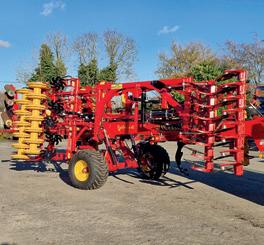

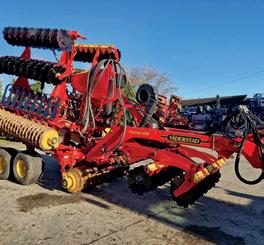
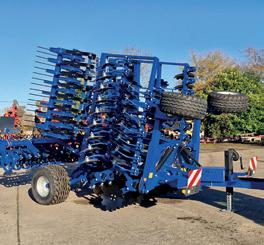

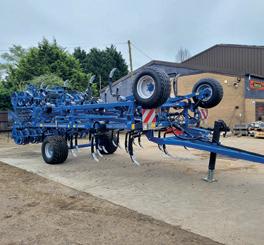


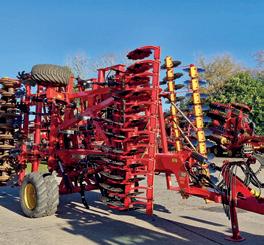

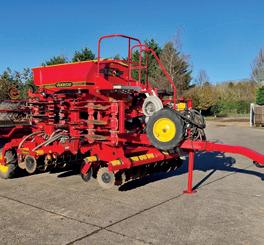



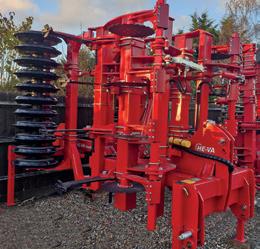

• Refi ned four-wheel-drive system
• Revamped and modern exterior
• Welcome upgrades in the cabin
The 2025 facelift Isuzu D-Max UK version has arrived – with a range of updates worth considering for those in the farming community.
Known for its durability and practicality, the D-Max has long been a reliable agricultural workhorse – and this latest iteration builds on that reputation. Changes aren’t radical – but do cater to the needs of farmers who require a robust and versatile vehicle.
The exterior has undergone subtle but noticeable changes. The front grille has been redesigned, giving the vehicle a more modern appearance without straying too far from its utilitarian roots.
The headlights have also been updated, now featuring LED technology, which improves visibility during early morning or late-night work on the farm. The overall shape remains familiar, with a focus on functionality.
Bed dimensions are unchanged and maintain its 1 tonne capacity to carry tools, feed, or livestock supplies. The addition of more tie-down points and an optional spray-on bed liner could prove useful for securing loads and protecting the truck bed.
Interior comfort
Inside, the cabin has seen some welcome upgrades. It is available in a number of versions – from the workready Utility trim to the highest specification V-Cross, the D-Max provides uncompromised levels of comfort and performance.
The seats are designed to be comfortable for long hours, whether
The front grille has been redesigned, with a more modern appearance
you’re driving to market or checking on fields. The infotainment system has been updated, featuring a larger touchscreen with improved responsiveness.
“
The engine delivers power and torque
While not as advanced as some systems found in more urban-focused vehicles, it includes features like Apple CarPlay and Android Auto. The inclusion of more USB ports and a wireless charging pad is a practical addition. Climate control has also been improved, with better airflow and the option to filter out dust and pollen, which could be beneficial during harvest season or when working in other dusty environments.
Under the hood, the D-Max retains its 1.9-litre turbo diesel engine. The engine delivers adequate power and torque for towing trailers, transporting heavy loads, or navigating rough terrain.
While it may not be the most powerful engine in its class, it strikes a balance between performance and fuel efficiency, which is important for those who rely on their vehicle
for daily tasks. Towing is unchanged at 3.5 tonnes.
The four-wheel-drive system has been refined, offering better traction in challenging conditions. Ground clearance and approach/departure angles remain competitive, ensuring the D-Max can handle rough and varied terrain.
Safety has been a focus in this update, with the inclusion of additional driver-assistance features. These include lane-keeping assist, adaptive cruise control, and a 360-degree camera system, particularly useful in tight spaces or limited visibility.
Reliability has always been a strong point, and there’s no reason to believe this will change with the 2025 model. Isuzu’s reputation for building tough, long-lasting vehicles is wellestablished, and the updates seem to align with that ethos.
Running costs, including fuel consumption and insurance, are reasonable, and resale value is likely to remain strong, which is an important consideration for those who view their pickup as both a tool and an asset.






The Isuzu D-Max claimed ‘Pick-Up of the Year' for the fourth year in a row in the 2025 Company Car & Van Awards. Still a firm favourite among many farmers, the vehicle continues to turn heads in the agricultural world with its practical workhorse pedigree and welldocumented reliability following back-to-back record sales years into 2025. Praised for its versatility and variety, the 4x4’s the
workhorse capability and off-road features across the vehicle’s range were singled out by judges – including Andrew Walker, of Company Car & Van magazine.






“When a pick-up wins an award four years in a row, it must be doing something right and the D-Max does that alright, he said. “It'll do the rough stuff while also tackling the urban jungle too.”






Work ready. Life ready. On or off-road ready. Isuzu’s awardwinning pick-up is equipped with even smarter styling, stronger performance and safer technology. Delivering the reassuring capability and durability you expect from Isuzu, our tough workhorse takes comfort and refinement to the next level.
Wherever, whenever, The New Isuzu D-Max is ready at a dealership near you.





Like it or not, few farms could survive without being in debt, says Clodhopper
Debt it is not something I’ve ever been comfortable with – and I suspect most farmers feel the same.
That hasn’t stopped me borrowing money, of course. I have taken out numerous loans over the years and I am more often in the red than in the black. But I still feel uneasy about it and I have never got used to it.
Much of that money has been borrowed for land deals to secure that elusive field of dreams to produce more food. Diversification projects were never important back in the day because a decent standard of living could be had from food production. Sadly, that is not the case now. The return on investment from food production is so poor these days that additional sources

of income are vital. In years gone by, I tried to repay my debt as soon as possible. How things have changed.
Forthcoming inheritance tax changes mean some people are taking on more debt in the hope that any borrowings can be offset against the tax liability when passing on the farm. The urge to save seems to have gone. The buzz-phrase is asset retention.
Large farmers appear more comfortable with the idea of borrowing money so they can expand their ever-growing businesses. Some take the alternative view and find outside investors to purchase land while the farming company does the manual work.
and bold
Seemingly worry-free about debt, they seem big and bold – although perhaps below the surface all is not what it seems. As one large farmer said to me: “Why use your own money when you can use somebody else’s?”
Of course, the well-known banks still lend to farmers. But the days of the specialist agricultural manager seem numbered. Instead, it’s a freephone number, a long wait and then usually a conversation with someone who can’t tell a cow from a sheep.


Thankfully, a specialist bank has now emerged to fill this gap. But funding still poses a problem for many farming families
– especially at a time of so much uncertainty and cost for the industry.
Low returns and the phase-out of direct support mean understandable concern about land valves. Lending is usually based on asset values and with current worries over tax issues, who knows whether land values will rise or fall?
Farms with larger borrowings may be in a better position. Lenders are often reluctant to foreclose on a business – so a bigger debt may be as much their problem as it us yours, if not more so.
Today it is more about debt restructuring. It seems to be encouraged to increase your debt in the hope that the asset value will eventually outweigh the liability – provided that financial conditions allow.
But there are few guarantees when it comes to capital growth. And having seen the way changes to the tax regime have prompted investors to flee the buy-to-let rental market, who is to say that the same will not happen to farmland?


To my mind, farms will always need to borrow. But it’s important to have a clear strategy. After all, lenders like certainty and will offer better rates if they know they will get their money back – with interest, of course.


Mark Schuurman (Director of Agriculture for Virgin Money) discusses the challenges and opportunities facing the agricultural industry and the importance of maintaining a forward-thinking mindset.
“The winter months can often be good for reflection, and the last period has seen so much to discuss, review and consider. However, as we move into spring, it’s more important to look forward and plan for upcoming activities.
With so much going on around the agricultural industry in terms of policy and tax changes delivering direct impact to all businesses, it’s understandably easy to get distracted by the many things we have no control over. At times like this, there’s no better time to look over the fences and see how others are adapting to, or dealing with

these headwinds.

driving down their environmental impact. Within all their targets and KPI’s, their focus is on the things they can control. This is of course much easier said than done, but even in the last few di cult years, there are standout farming businesses with levels of performance that (based on any number of measures) do not relate to their scale, industry, or age/experience.

actually distract from prudent decision making that supports an overarching logical strategy? And at the same time, the availability of a grant does not justify an investment in itself.

In my experience of supporting both farming and other industries, the most successful business owners seem to retain a steely focus on their own strategies, which could be sales growth, maximising production, ruthless cost e ciency or
This is because the individuals just don’t get blown off course, and that’s what makes my role so satisfying. It’s the people that make businesses work. Do they have a clear long-term strategy, and does this influence short-term decision making or not? How are challenges approached? How do they manage people and those other stakeholders who may influence their operating environment? How much time do they spend away from their business, not just looking over the fences but getting under the skin of the drivers of performance of the best
As funders, we think in terms of risk and risk mitigation, and recognise that the agricultural industry right now has everincreasing exposure to the free market with subsidised food production now almost non-existent. This is systemic change, and farmers and landowners in the future will need to be even more agile, ever closer to their customers, the consumer and end users of their products, and to some degree reduce their sole reliance on food or production from land or business.
which could be sales growth, maximising

businesses out there? business to build resilience.
It does of course depend on financial management too, and all the same challenges apply. There will continue to be pressure on farming incomes because of climate change, geopolitical pressures, commodity prices and government policy, but none of these variables outside a business owner’s control should divert attention from what can be done to mitigate, insure and diversify a
Another issue I often debate with customers is that of grants. I am trying in this article not to get blown off course myself and blame Government policy, so I come back to my challenge that any investment opportunity really should stand on its own merit. If an investment makes good business sense because it will deliver a return, be it financial, environmental, in greater e ciency or whatever measure you value, then waiting for a grant to appear
on its own merit. If an investment makes potentially just delays the benefits.

I recognise the value of grants, and you don’t want to miss out if they are available, but do they

While we support the various campaigns that may positively impact central government decision making, maybe more importantly such campaigns can actually more positively engage the UK consumers. It’s an inevitable reality that farming businesses will require the pursuit of diversification opportunities around their core enterprises to deal with ongoing demand and price variability, sustain pressures from imports and build resilience to reduce risk across the sector. Reducing the gap between the population and how our food is grown and sourced is a responsibility for us all in the industry but also allows a variety of other opportunities to be pursued.
As bankers to such a critical sector, we remain positive about the future of farming and food production. We anticipate ongoing change, and we consider that as an opportunity to support forward-focused businesses with the agility and vision to move forward towards their goals whatever headwinds that materialise. Mindset is critical in delivering positive outcomes and I share that positive approach with our customers. I encourage you to surround yourselves with those who you look up to, learn from the focused and forwardthinking, and don’t spend too much time on those things you just can’t control!”
Colin Aitkenhead (Midland) colin.aitkenhead@virginmoney.com






Professional 500m Drainjetter, Three Piston Diaphragm Pump 50 Bar, 500m Special Hose, 10m Water Suction Hose, 6m Overflow Hose
£23,140 +VAT











